Boat Navigation Lights Rules: Illustrated Beginners Guide
When navigating at night, the lights on other boats are your first clue about the moving dangers around you. And your navigation lights are your first line of safety in avoiding collisions in the dark, and they tell others vessels what you are and what you are doing. The rules sound complex, but with a little understanding you can get the basics for any situation.
So what are the basic navigation light rules? For most small vessels, motoring requires red and green (port and starboard) lights, and a white light visible in all directions around the boat. This is almost always a stern light and a masthead light on sailboats. Boats under sail require port and starboard lights, and a white stern light. Sailboats below sixty-five feet may show a tricolor light at the masthead instead of side and stern lights when sailing.
That's it, in a nutshell. There's a little more to it, as the rules change with different sizes and there are some specifics about angles of display for the colors. Identifying other ships at sea requires more study, but the basics are the same. And it's not much trouble to make sure you've always got the proper lights on your vessel.
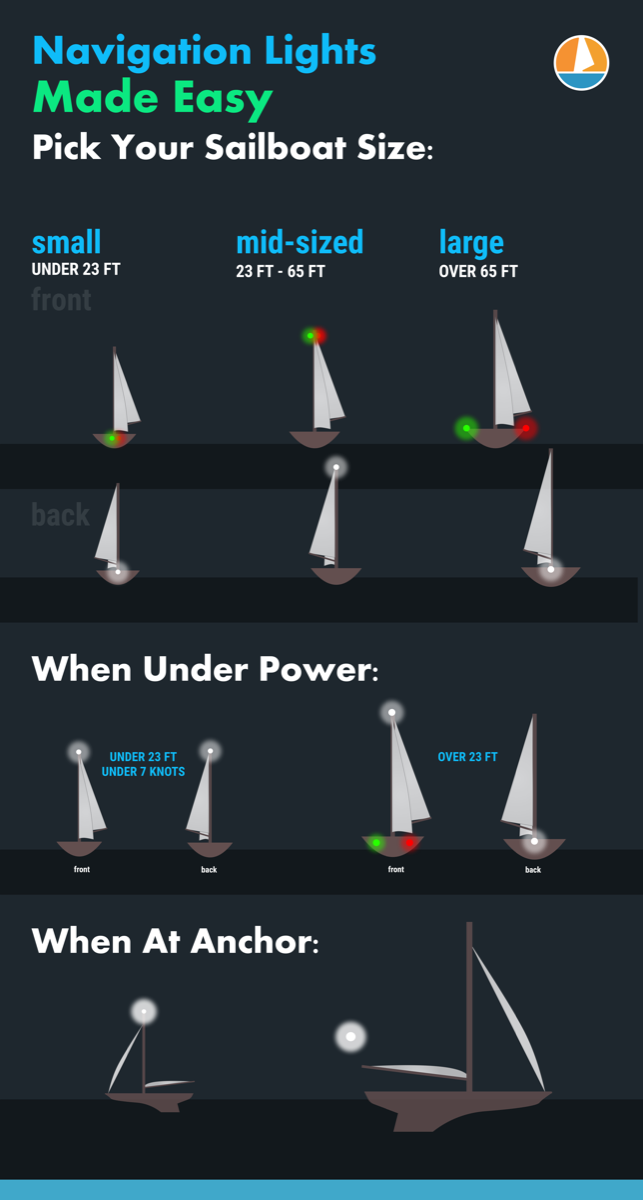

On this page:
What are the official colregs rules for your sailboat, what about the uscg (united states coast guard) rules, lighting at anchor, identifying the boats around you.
The International Regulations for the Prevention of Collision at Sea , abbreviated "COLREGS" is very specific about the lights required, their shapes and sizes, and the distance they must be visible. For the smaller boat, the following definitions apply.
- Masthead Light - a white light placed centerline on the boat showing an arc of 225 degrees with 112.5 degrees either side of the front of the vessel.
- Sidelights - A red light on the port side and a green light on the starboard. They must show an arc of 112.5 degrees from centerline of the bow.
- Stern light - A white light on the stern of the boat showing an unbroken arc of 135 degrees from centerline of the vessel.
- All-round light - A light showing in an unbroken arc of 360 degrees.
The good news is you need not measure these angles. Any properly installed USCG or COLREGS approved light which will cover the correct arcs. If you have to replace the original light from your boat, make sure it's with an approved replacement.
Lights When Sailing
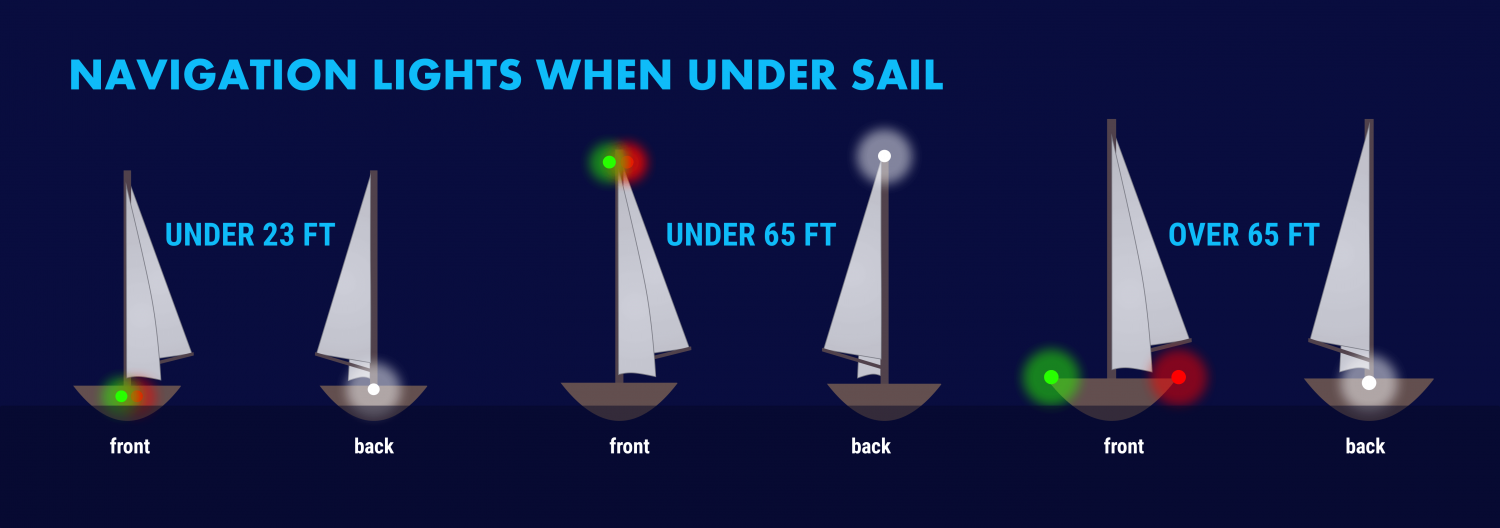
The specific rules for a sailboat under sail are in COLREGS Rule 25 and vary slightly with the size of the boat. A sailboat powering is considered a power boat and falls under in Rule 23.
- Under 23 feet (7 meters) - side lights and a stern light, possible. If these lights can not be displayed a light must be kept at hand to help avoid a collision. This can be a bright flashlight.
- Over 23 feet - Side lights visible to one nautical mile and stern light visible for two.
- Vessels under 65 feet may combine both sidelights into a single lantern on the bow.
- May show a tricolor light on the masthead instead of sidelights and a stern light. It's one or the other though, do not show these lights at the same time .
- Masthead light must be visible for three nautical miles, all other lights must have a two nautical mile visibility.
- Side lights must be separated.
- May not show a masthead tricolor light.
- Masthead light must have five nautical mile visibility, all other lights must be visible for two nautical miles.
- Optional masthead lights - any vessel under sail may display a red light over a green light at the masthead with sidelights and stern light. The red over green may NOT be displayed with a masthead tricolor light. It's one set or the other.
Lights When Motoring
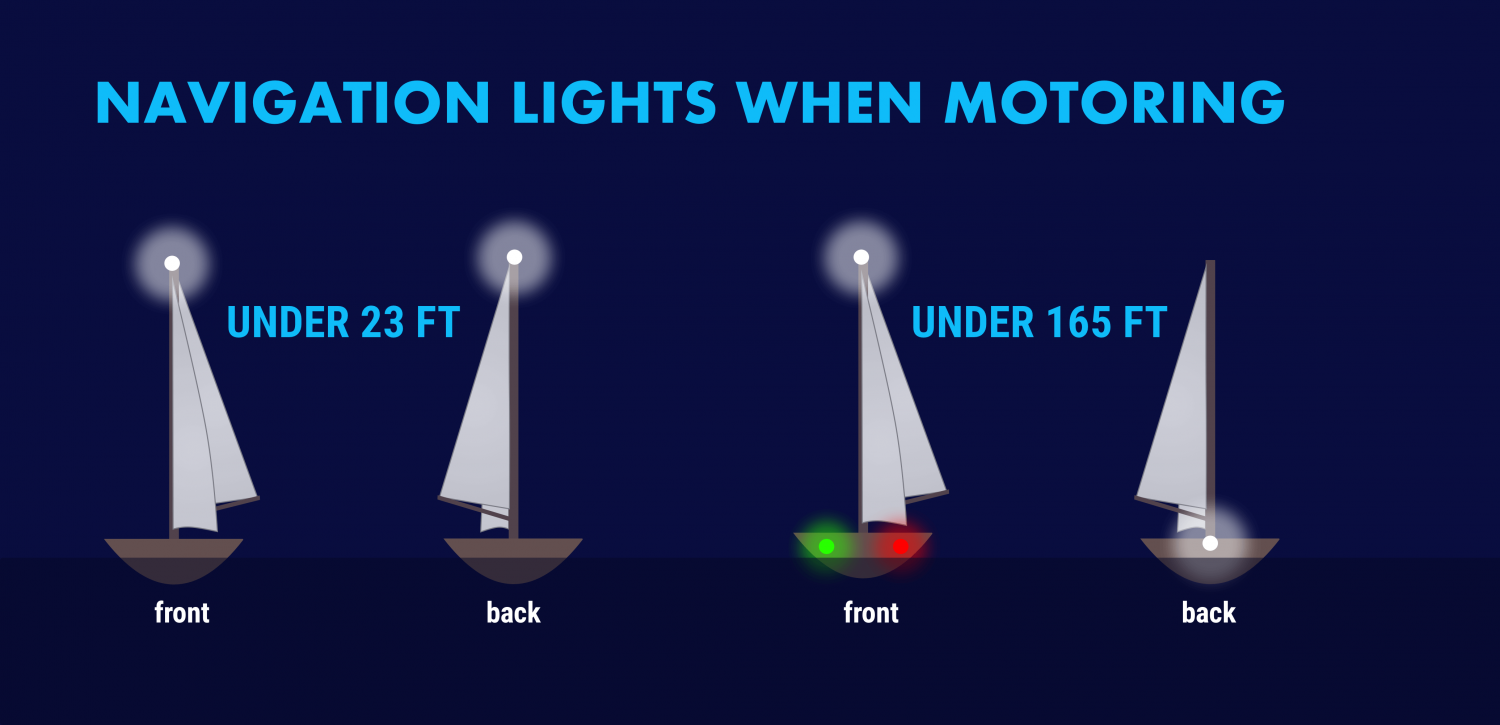
For all navigational purposes a sailboat under power is considered a power boat. This includes motor sailing - if the engine is on and providing propulsion you are on a power boat, even if the sails are up . This applies to navigation lighting, sound signals in fog and limited visibility, and rights of way.
Sailboats under 50 meters under power need to show:
- A masthead light
- Stern light
A power-driven vessel under 23 feet (7 meters) that does not exceed seven knots of speed may display an all around white light, though sidelights should be used if available.

The USCG has published its own "Rules of the Road" that are based on the COLREGS. In addition, it has rules for the "Inland Waterways" for rivers, inland lakes and the Great Lakes.
The good news is this has no impact on what you have to do with your own boat.
They mostly relate to lighting changes on towed vessels like barges and tugs. For example, a vessel towing or pushing another vessel in the ocean under COLREGS shows two masthead lights, sidelights and a stern light, whereas in Inland Waterways the towing or pushing vessel displays two yellow towing lights instead of a white stern light.
If you sail on lakes, rivers or the Great Lakes where towed commercial traffic is common you should learn the inland lights, but coastal or ocean sailors will never see these.
When you anchor outside a designated mooring field, you should display an all around white light at the masthead or as high in the boat as practical.
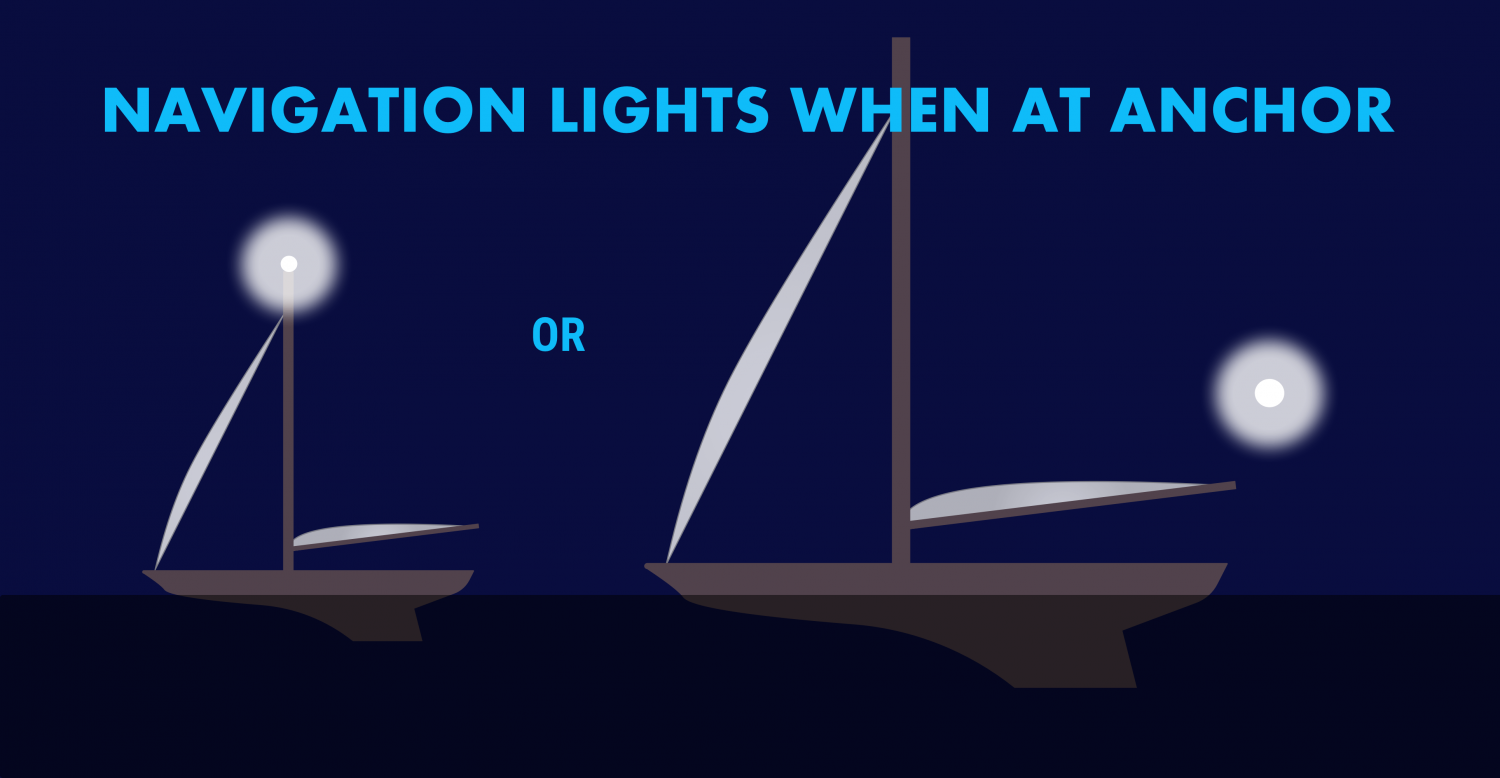
If your boat is large and has a very tall mast, you may wish to display another light closer to the waterline. Boats approaching in the dark may not see a light on a mast sixty or seventy feet in the air when they are close to your boat.
We use a simple garden path light on our stern when we anchor, left in a rod holder or flag socket. It comes on automatically at dusk and is a cheap and easy way to be more visible. There is no specific rule stating you can not display more lights than required, or the nature of any lights beyond the required all around light.
The COLREGS also specify that a round black "daymark" should be displayed in the rigging of any vessel at anchor. Very few small vessels observe this, however it is the correct display for a vessel in an anchorage.
If you tie to a mooring in a marked mooring area you are not required to display anchor lights, but there is no harm in doing so.
The other important reason to know your lights is to figure out what's going on around you at night. The water may be ablaze with white, red, green and other lights at night and they are your first key to avoiding collisions and problems.
All combinations of lights for fishing boats, commercial vessels, and so on are outside this post‘s scope. The odds are small you will encounter a submarine, seaplane or hovercraft at night, but there are regulations regarding specific lighting for each of those vessels!
There are a few fundamentals to help you figure out what that is you see on the horizon, which way it is going, and whether it is a danger to you.
Port Wine is Red
The fundamental rule is that red sidelights will ALWAYS be on the port side of a vessel, and green lights will always be on starboard. However, some vessels can use all around red and green lights for other purposes, though those will be higher than sidelights.

The light‘s on a ship is not important, some large tankers and freighters will have their sidelights far aft and put them on the superstructure for better visibility. It is not safe to assume that sidelights you can see are on the bow of large vessels .
When you can see the color, you know which way the bow is pointing. If it's red, it's pointing more or less to the left and will travel in that direction. A green light shows it is heading more or less to your right.
If you can see the red and green lights at the same time, you are looking directly at the bow of the vessel. When you are far away, this isn‘t as alarming as if you are close crossing. Seeing red and green lights together on a vessel is something you never want to see for long.
Be aware of red and green lights used in combination with other red, green and white lights. These may not be running lights and could have other significance.
Tankers, Freighters and Large Ships
Tankers, freighters and large ships will have side lights, a stern light and a masthead light. In addition, on vessels over 50 meters there will be a second masthead light further aft and higher than the forward light. The masthead light positions are a better tipoff to the bow direction and how far from the bow the sidelights might be. Remember - on a large vessel the sidelights may not be at the bow or even close to it.
USCG Inland Rules allow for a second all-around white light on large vessels on the Great Lakes instead of a second masthead light.
Fishing Boats
Fishing boats engaged in fishing will have more complex light displays. When they aren't fishing, they will show lights like any power vessel, but Rule 26 spells out light combinations that vary by the fishing activity being done. In general:
- Boats which are Trawling but not making headway will display a green all-around light over a white all-around light , and a masthead light aft of these lights. Boats making headway while trawling will show these lights, plus sidelights and a stern light.
- A vessel fishing other than trawling will show a red all-around light over a white all-around light . When making way they will also show sidelights and a stern light.
- If a vessel has gear more than 150 meters away from the boat, it will show a second all around light in the direction of the gear. The best rule is to give fishing boats as wide a berth as you can at night. They're easy to pick out if you check the top light configurations but their course may be difficult to predict.
Towing and Pushing
Towed vessels can be the most dangerous to cross, but they have the most lights to tell you what is happening. Refer to COLREGS or the USCG Rules of the Road Rule 24 for all combinations You can pick a tow/push vessel out with the following lights:
- Two or three masthead lights in a vertical line. Three masthead lights shows a tow over 200 meters. Additional masthead lights may show for larger tow vessels.
- A towing light (yellow light with the same characteristics as a stern light) directly above the stern light.
- The will also have side lights and a stern light.
- The towed vessel will show sidelights and a stern light. Lighting may vary under USCG inland rules, where towing lights may replace stern lights. Learn these differences if this is your regular cruising ground. If you think there is a tow ahead of you, always go well behind the aft most set of lights. Never go between a tow and avoid crossing ahead if possible as it may restrict their maneuverability.
Special Situations
There are several rare situations you may encounter. As a general rule, if there are a lot of lights and you don't understand them look for the sidelights on a moving vessel. If you can find them and figure out the direction it is moving, it makes the vessel easier to avoid. Stay well clear of lights you do not understand if you can avoid them without risk.
Most of these signals are used by larger, commercial vessels and you will not need them.
They use these light combinations with other light combinations. For example a towing vessel may also be restricted in maneuverability, and a vessel constrained by draft will show running lights if moving.
- Not Under Command - two all around red lights in a single line
- Restricted in Ability to Maneuver - red, white then red in a single line
- Constrained by draft - three all around red lights
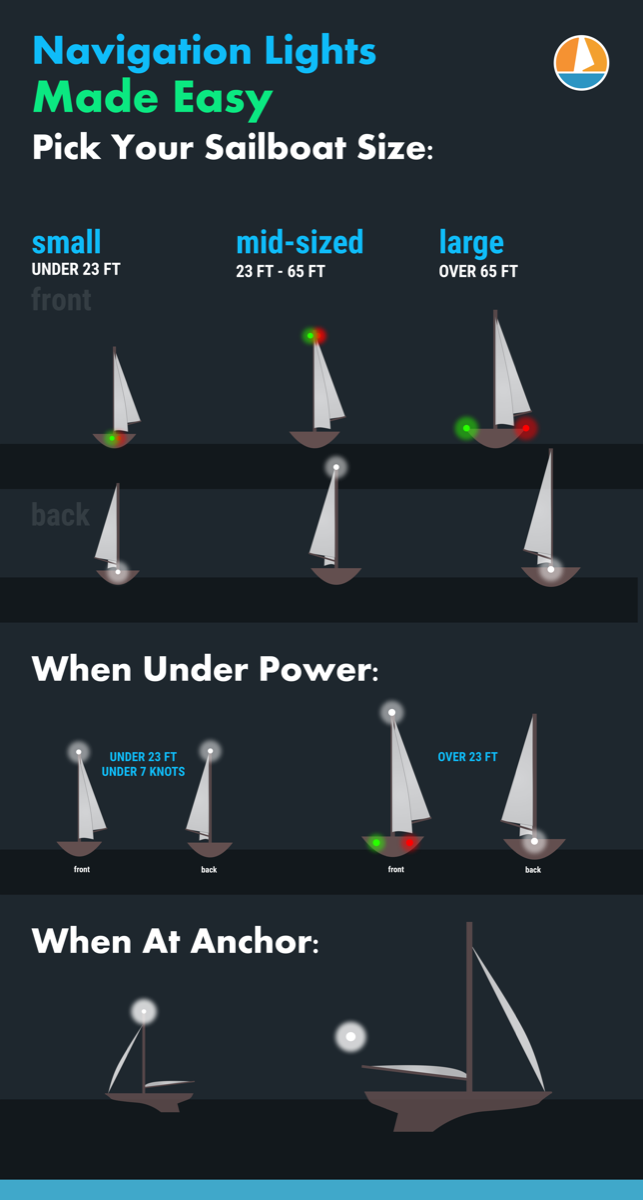
Leave a comment
You may also like, 17 sailboat types explained: how to recognize them.
Ever wondered what type of sailboat you're looking at? Identifying sailboats isn't hard, you just have to know what to look for. In this article, I'll help you.

The Ultimate Guide to Sail Types and Rigs (with Pictures)
Own your first boat within a year on any budget.
A sailboat doesn't have to be expensive if you know what you're doing. If you want to learn how to make your sailing dream reality within a year, leave your email and I'll send you free updates . I don't like spam - I will only send helpful content.
Ready to Own Your First Boat?
Just tell us the best email address to send your tips to:
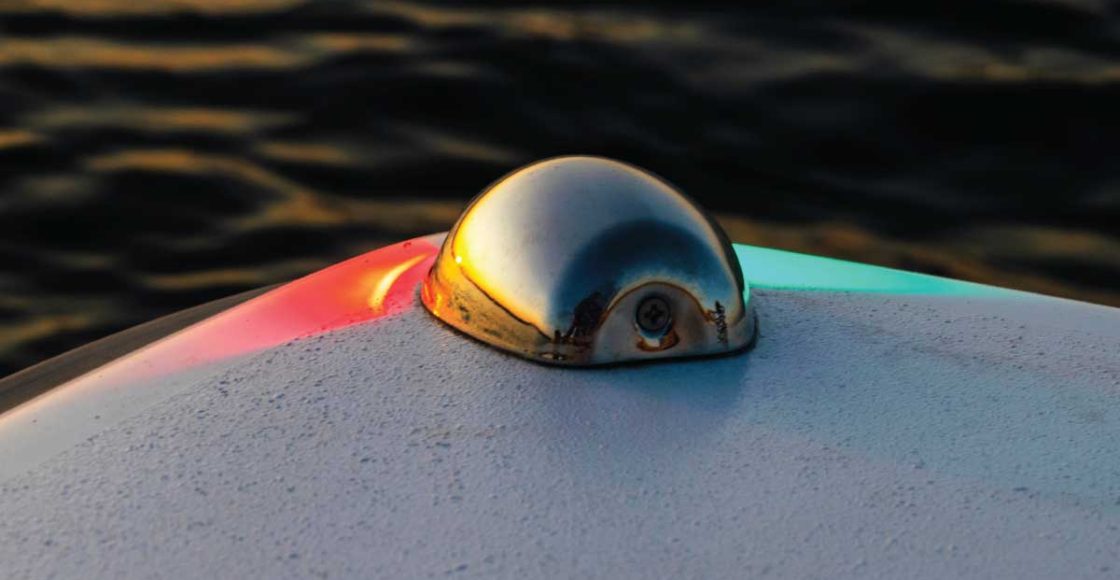
Boat Navigation Lights: Understanding the Basics

Table of Contents
For many boaters, the best way to end a beautiful day on the water is to watch the sun slowly drop below the horizon while it lights up the clouds and sky above. Others feel better heading to the dock before the sun goes down, while there is still plenty of light to illuminate the channel markers and other potential dangers.
Besides understanding boat navigation light rules, it is also important to understand:
- The overall purpose of boat navigation lights
- How to properly use boat navigation lights
- What the different colors (red and green) mean
Own a boat? Earn an avg. of $20K per season renting it out on Boatsetter
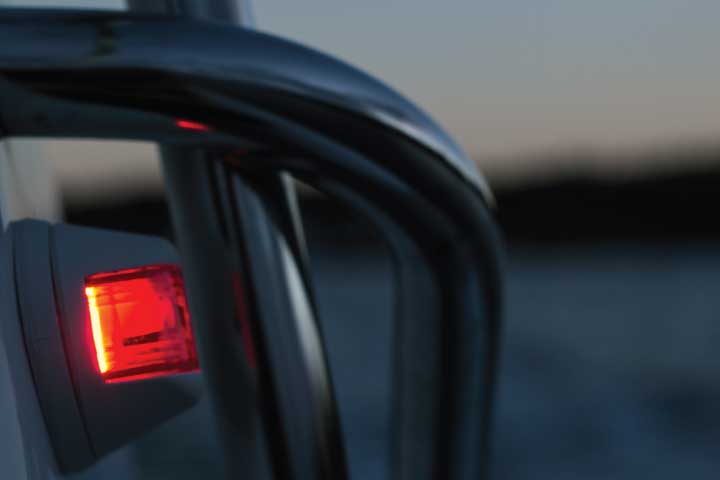
How do boat navigation lights work?
Boat navigation lights, or “nav lights,” are the colored marker lights visible on either side of the vessel and at the stern . These lights play essential roles in identifying the ship’s length, direction, and purpose!
The colored marker lights and where to find them go as follows:
- The boat’s port side is marked with a red light.
- The starboard side light is green.
- When looking at the boat’s transom or stern, a white light may be visible.
Keep in mind large boats and ships may use other colors, like yellow.
Next time you’re boating at night , say thanks to your navigation lights. They allow you to see other boaters in the dark and help prevent collisions. But there is much more to boat navigation lights than that.
How to use boat navigation lights
Each of the boat’s navigation lights is only visible for so many degrees of a circle to prevent confusion and accurately identify which side is in view.
By noting which colors are visible on another vessel, boaters can identify which direction the other boat is facing or headed. Knowing a boat’s direction can be especially important when crossing paths with another vessel in the dark.
If you walked around a boat at night while the navigation lights were on, the color visible would change depending on where you stood. When looking at the port side of the boat, the red light would be visible from dead ahead of the vessel to just past the center of the port side or through 112.5 degrees of a circle. Walk to the starboard side, and the green light would be visible from the bow to just past the boat’s center, or another 112.5 degrees.
Stand at the back of the boat, and you will see the white light visible for a total of 135 degrees from one side of the vessel to the other. Add up all three, and you’ll get 360 degrees.
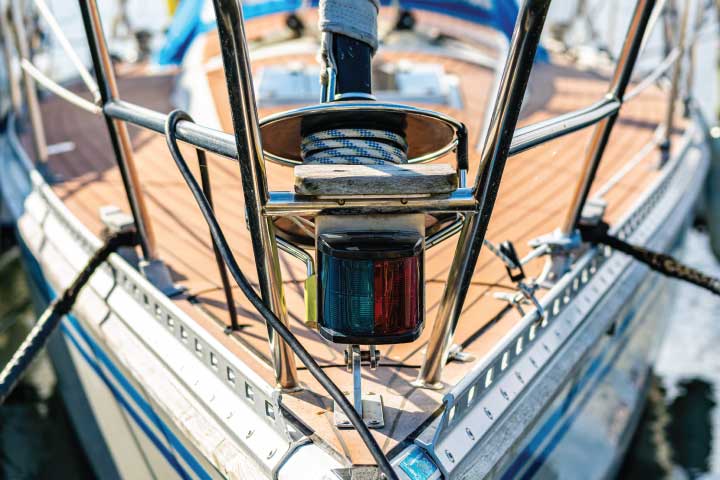
Boat navigation light color meanings
If you were on a boat at night and could see nothing but the different colored lights of another vessel ahead of you, you would still know exactly which way that boat was going.
- If you could only see the red light ahead of you, you would know that you are seeing the other vessel’s port side, or it is crossing in front of you from your right to left.
- The opposite is true if you saw the other vessel’s green light . You would be looking at the other vessel’s starboard side or watching the boat pass in front of you from left to right.
- If you see both red and green lights , then the other vessel is coming straight at you if you can see both red and green lights.
- If you can only see the white light and nothing else, you would look directly at the other boat’s stern as it drives away.
- Red and white means the boat is driving away from you, crossing from right to left.
- On the other hand, green and white signal that the vessel is moving away from you, crossing from left to right.
When renting a boat on Boatsetter , make it a habit of checking that navigation lights are working. You should turn on the navigation lights even if the sun is out. It’s the best and safest boating practice.
Want additional resources for boating?
Check out the links below for more information on boating.
- Navigation lights study guide
- Pre-departure boating checklist
- Boat Spring Commissioning Dewinterization Checklist
Don’t let your boat sit idly by. List it with us to earn $20K on avg.

Chuck Warren fell in love with boats at 9 years old while helping to restore his grandfather’s 1939 44-foot Elco cruiser. A lifelong boater, Chuck has experience operating large and small vessels on the waters of the Atlantic, Gulf of Mexico, Caribbean, and the Great Lakes.
During his 35-year marine industry career, Chuck has been the driver for several offshore powerboat racing teams, the chief engineer aboard a Caribbean research and salvage vessel, captain of a Florida Keys sunset cruise, and more.
Today, Chuck is a boating industry writer, copywriter, and captain who lives on his 40-foot boat in the summer when he isn’t delivering vessels around the Great Lakes or teaching new boaters to drive. Winters are split between the West Michigan lakeshore and wherever his travels take him.
Browse by experience

Explore articles
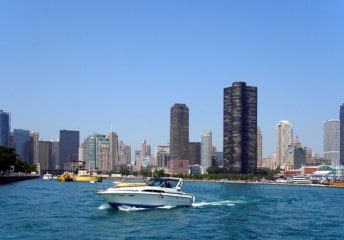
Beaches, boats, freedom with July 4th boat rentals in Chicago
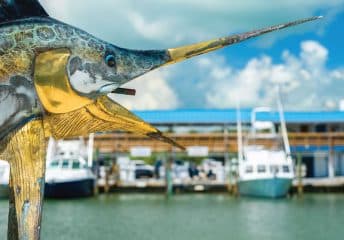
Fishing in Islamorada Guide
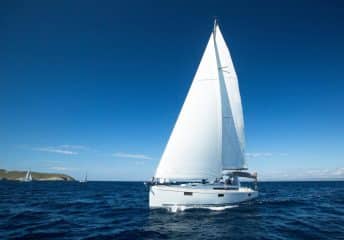
8 Great New Sailboats for 2022
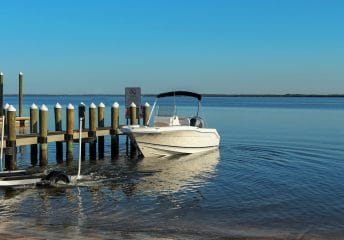
Pre-Departure Boating Checklist: 20 Things to Do Before Leaving the Dock

Please verify you are a human
Access to this page has been denied because we believe you are using automation tools to browse the website.
This may happen as a result of the following:
- Javascript is disabled or blocked by an extension (ad blockers for example)
- Your browser does not support cookies
Please make sure that Javascript and cookies are enabled on your browser and that you are not blocking them from loading.
Reference ID: 41c45624-eee7-11ee-870d-e08630fd89d0
Powered by PerimeterX , Inc.
Get your card today

- Pre-paid code

- Buy a Gift Card
Boat Navigation Light Rules and Requirements

Boat navigation lights are one of the most important pieces of safety equipment on your boat, along with personal flotation devices , boat fire extinguishers and boat ventilation systems .
As a boat owner or operator, you are legally responsible for using the correct safety equipment at all times. This is your responsibility whether your boat is moving through the water or you are at anchor, day and night, in all types of weather.
Did you know that boat manufacturers, importers and dealers are not responsible for equipping your boat with legally acceptable navigation lights ? Before you take to the water, check that your navigation lights are:
- the right size and type for your boat and chosen water activity
- the right color and intensity
- attached to the correct parts of your boat
- fully operational.
It’s important to learn all you can about navigation lights for safe, legal boating! Keep reading to find out which lights to use when.
What are navigation lights for?
Navigation lights allow you to see and identify other vessels, and allow other boats to see and identify you. There is not one simple way to use navigation lights; the way they are set up on your boat will indicate the size, activity, and direction of travel of your vessel, so that you and other boat operators can make good decisions and avoid collisions.
By understanding what navigation lights mean, you will be able to safely and legally navigate shared waters under a variety of circumstances.
Boat navigation light requirements
Paddleboats, rowboats and small sailboats generally do not need to display navigation lights, but most other boats are legally required to use some or all of the following:
- A green light to indicate the starboard (starboard sidelight) attached near the bow on the starboard side
- A red light to indicate the port (port sidelight) attached near the bow on the port side
- One or more white lights (stern light and masthead light)
- Other navigation lights , such as blue flashing lights for law enforcement vessels engaged in search-and-rescue (SAR) operations, or yellow lights for vessels that are towing or being towed
Each type of navigation light also has a defined arc of illumination and range of visibility. Angles of visibility must be met when the boat is underway, which means that if your boat rides at a significant bow-up angle, you may need to adjust your navigation lights to compensate.
You must always use navigation lights between sunset and sunrise or in reduced visibility, but there are some exceptions during clear, daytime boating.
Note: It is also important to keep a flashlight on board as a temporary replacement, in case a navigation light burns out.
Boat navigation lights while underway
While your boat is underway, you are legally responsible for displaying the right type of navigation lights. Choosing the right lights depends on several factors, including:
- Whether your boat is powered by an engine (in full or in part)
- The size of your boat , measured in length
- Your boat’s speed
- Where you are boating (inland, international water, etc.)
- Whether you are at anchor.
Remember that your navigation lights must be visible and easily identifiable as such. Other lights on your boat cannot be mistaken for navigation lights, or get in the way of your navigation lights
Sailboat navigation lights
If you are operating a sailboat or nonpowered boat such as a canoe, kayak or rowboat, you still need to use the correct configuration of navigation lights for your boat size and boating circumstances. For comprehensive detailed instructions on navigation lights please refer to the USCG resource. The following are general guidelines:
Sailboats or vessels using paddles or oars, under 23 feet in length:
- One white navigation light (or lantern or flashlight) that is visible from 2 nautical miles away between sunset and sunrise or during periods of low visibility. In the presence of another vessel, the light must be displayed in time to avoid a collision.
Sailboats between 23 and 65.6 feet:
- One white stern light visible at 135 degrees and from 2 nautical miles
- One green starboard and one red port sidelight, visible across 112.5 degrees from one nautical mile away
- A tricolour light, which is a single all-around light which includes the three coloured of lights indicated above, facing the same directions, visible from a distance of 2 nautical miles. This type of light can only be used when under sail, and never when using a motor regardless of whether the sails are hoisted. It may not be used at the same time as regular sidelights.
Powered boat navigation lights
If you are operating a boat with an engine (including sailboats with motors), between sunset and sunrise or under conditions of restricted visibility, you need navigation lights.
Powered boats under 39.4 feet:
- One all-around white light, visible from all directions (360 degrees) from two nautical miles away. This light must be attached at least 39 inches above the sidelights.
Recreational powered boats between 40 feet and 164 feet:
This size of boat requires two white lights which, combined, make up 360 degrees of visibility:
- A white masthead light at the bow, visible across 225 degrees, from 2 nautical miles away. This light must be attached at least 8 feet above the gunnel.
- A white stern light at the stern, visible across 135 degrees and from 2 nautical miles away.
In addition to:
- One green starboard and one red port sidelight, visible across 112.5 degrees from one nautical mile away.
Boat navigation lights at anchor
When your boat is anchored at a dock, it is not necessary to turn on your navigation lights. However, if you are at anchor in an undesignated area, you need to make other boats aware that you are not moving by displaying an all-around white light where it will be easily visible to any other boats in the area.
Diving lights
If you are boating in a resort area or anywhere there are sunken wrecks or coral reefs, keep in mind that there could be diving activity. Keep your distance and stay alert to the possible presence of divers underwater.
Boats that are accompanying divers must display:
- Three vertical masthead lights in a red-white sequence.
Interpreting boat navigation lights
Installing and using the right navigation lights on your boat is very important, but to navigate safely, you also need to be able to interpret the navigation lights on other boats.
Remember, you may not always be boating under ideal circumstances. Make sure you learn to understand navigation lights and the United States Coast Guard rules of navigation , also called the Rules of the Road , thoroughly, so that you can make good decisions quickly, as needed.
Do you see a green light over a white light? This indicates a fishing vessel that is actively trawling. It may be necessary to avoid not only the boat, but also a large net.
Do you see a red light to the left, with two white lights to the right? Understand that you must yield to the other boat.
There are many other configurations you need to be familiar with to operate your boat safely.
Avoiding collisions
Remember, navigation lights are only a tool. You must also maintain a proper look-out at all times, by sight and hearing, to responsibly avoid collisions. Skippers must drive at an appropriate speed so that you can take effective action to avoid colliding with another vessel or body under or on the water.
Factors like visibility, traffic density, the maneuverability of your vessel, the presence of other lights from shore or scattered boat lights, the state of the sea and the draft in relation to the available depth of water must always be taken into consideration. Radar equipment may also pose certain limitations or offer certain benefits to navigating safely.
It is the boat operator’s responsibility to do everything in their power to avoid a collision, including but not limited to the correct display of navigation lights.
Learn about boat navigation and more from Drive A Boat USA!
Driving a boat safely demands a thorough knowledge of navigation, safety procedures and other technical details.
What you need to know depends in part on where you intend to go boating, the size and type of boat you will use, and what type of activity you will be engaged in, but there are many basic rules and regulations that you are legally obliged to follow no matter what the circumstances.
You can get your official state-approved online boating license today! Sign up for our fun and engaging boating safety course to get started.
- USA Boating
Latest Posts
- Cold Water Immersion: How to Survive Falling Overboard
- Capsizing a Boat or Falling Overboard: What to Do?
- Boat Operator Responsibilities and Rendering Assistance
- Four Stages of Cold Water Immersion and Hypothermia Chart
- Guide to Towing and Trailering a Boat
- February 2024
- December 2023
- October 2023
- September 2023
- January 2023
- November 2022
- Get certified now
- Replacement California Boater Card

Ultimate Guide To Marine Navigation Lighting
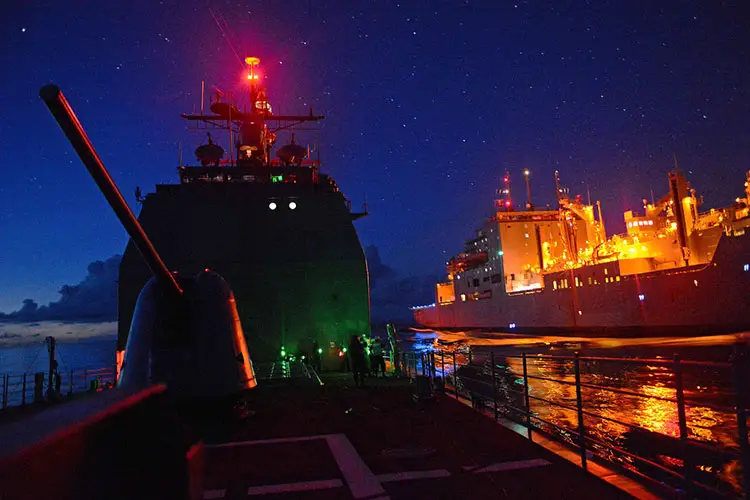
If you drive a car or even ride a bicycle, you might be well aware of the necessity of lighting systems (though in the second case the word ‘system’ doesn’t quite apply) for the safety of you and the people around you. The thing applies just as well for ships. But since they are much larger than a car, the lighting system or navigation lights on ships is a little bit more complicated as well. Marine navigation lighting is also one of the most critical aspects of nautical studies.
It is mandatory for boats of all sizes to have a navigation system . This is to make sure that the chances of any significant accident are minimized. The United States introduced the system in 1838, and the United Kingdom followed suit. Before being internationally adopted in 1897 suitable guidelines were established by the International Maritime Conference which was established in 1889. Three colors were chosen that were to be used for the light colors. They were red, green and white. This was based on a set of rules specified by the US and are followed around the world to this date.
This article discusses the different rules and regulations of using navigation lights, their importance, and also some basic marine navigation lighting systems along with their positions and ranges.
Marine Navigational Lights, Rules and Regulations
A standard pattern of marine navigation lighting is followed for the identification of both the vessel as well as the IALA buoyage system at night. If you are required to move from sea to a channel you need to have a list of all the IALA as well as the other fixed navigational lights that are visible on entering the channel. This includes distant lighthouses as well.
If you also make a note of the inland features like the radio and television transmitter masts it will benefit you because they act as good navigational aids due to their height and warning lights.
The helmsman should not be using any bright light source in the cockpit area and should rather take the aid of red lights and very dim white lights in the galley and navigation area. This is because he needs to preserve his night vision so that he can accurately interpret both the buoyage marine navigation lights as well as the boat navigation lights of other vessels.
The nautical almanacs contain the details of each and every visible maritime light signal coming from navigational markers that are both inside and outside the channel.
All the details about any particular light can be found in a published list or on a marine navigational lights chart: its color, period, and in some cases even the elevation and range of the beacon. Use the chart to keep a tag on the lights you are passing by putting a tick mark on the lights that you are about to pass and as the boat sails past, the tick is checked.
You will get two visual clues to figure out how far you are away from a buoy. The light will elevate from the horizon at 0.5 nm and at about 200m, the light will reflect on the surface.
Position of Boat Navigation Lights
Most of the variations that can be found in the different vessels can be read about in most almanacs. At the very basic level, a vessel needs to show a red light to port and green light to starboard. Depending on the size of the vessel, one or more colored or white lights are used as well.
For vessels that are 12 ft in length or shorter, the navigation lights must be visible from a range of one nautical mile and for the ones that are longer than 12 meters the required visibility range is 2 nautical miles. From 5 degrees above to 5 degrees below the horizontal happens to be the required minimum intensity in a vertical sector.
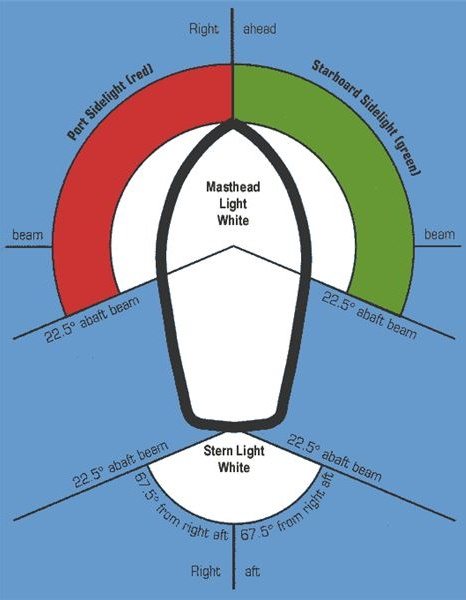
International Navigation Rules state that the boat navigation lights should be placed above the uppermost continuous deck. In case separate fixtures are used for the red and green sidelights, the masthead or all-round white light is placed as close as possible to the vessel’s fore and aft centerline. The masthead or all-around light needs to be positioned at least 1 m or 3.3 ft above the sidelights.
Following are the basic positions of navigational lights. We will discuss the same in greater detail ahead.
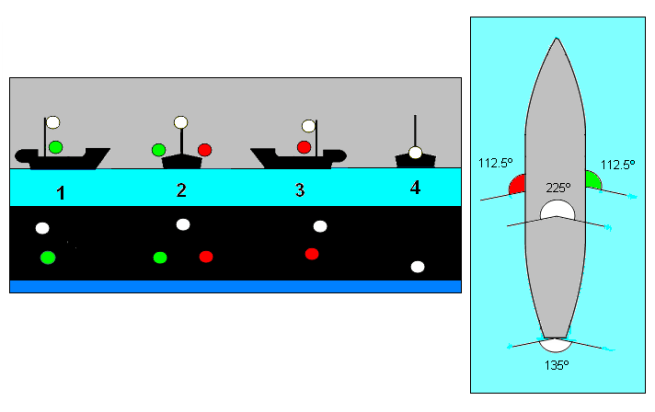
Also read: What Is A Marine Sextant?
Boat Navigation Light Regulations
Several rules and specifications are related to the type, size, layout, arc, and distance of visibility of boat navigation lights used by all vessel types which are collectively known as the International Regulations for Preventing Collisions at Sea or COLREGs . The navigational lights used are known as ‘COLREG lights and shapes. A boat might be anchored or underway, under sail or power, or fishing or trawling. These various situations can be communicated through multiple combinations of boat navigational lights.
In addition to the primary navigation lights, vessels may also display one or more steaming lights. These lights are very useful for it gives details about the various aspects of the ship like whether it is in the sail or under power, the direction in which it is going and, in some cases, even the size of the vessel. If a ship is engaged in a specific task that might involve certain restrictions, that too can be indicated with some extra boat lights.
Always maintain the lighting system and display the correct navigation light combination to make other vessels in the vicinity aware of your course and state as to whether your vessel is under power or not. If you follow this a considerable amount lowers the chances of a collision. Here is a list that you might use to familiarise yourself with the basics of the lighting system.
- Basic Navigation Light White Light : Small dinghies that are 7m or less in size are required to carry a torch having a white light that can be flashed when needed.
- All-Round White Light: An all-round white light is expected to be displayed by a small boat, up to 7ft long that is under power and can go beyond 7 knots of speed. This light must be visible at an angle of 360 degrees and from two miles away. An all-around white light is also used when the boat or vessel is at anchor but not at a designated anchoring area. This is to make sure that the ship is visible to all the nearby ships to avoid any accidents.
- Stern and Combined Side Lights : A stern light is a white light that is installed at the end of a boat. A vessel that is over 7 m or 23 ft in length is expected to show red and green sidelights when sailing. Each of these lights needs to cover an arc of 112.5°. The sidelights may be combined in one lantern at the bow when below 25 m or 65 ft. The white stern light can be seen over an arc of 135°. These lights need to be visible from a distance of a mile and need to be placed 39 inches below all white lights for boats of lengths equal to or less than 12 ft.
- Masthead Light : A combination of sidelight and stern light in a tricolor combination may be used sailing yachts of heights 20 m or lower. A masthead light is required by vessels of lengths between 39.4 ft and 65.6 ft. It is placed in the masthead whose height provides excellent visibility. Still, stern lights and sidelights should be fitted separately in case of or use under power along with steaming light. This kind of light needs to be visible across an angle of 225 degrees and from a minimum distance of 2 miles.
- Separate Lights : The displaying of the tricolor masthead light is not allowed in the case of yachts that are longer than 20 m or 65 ft. Instead, they use them separately. Often on large sailing vessels, these all-around, red over green lights are present. These red and green sidelights need to be visible from a distance of one mile and across an angle of 112.5 degrees.
- Steaming Lights Combined Lights : A combination of the masthead and stern light are used in the case of power crafts that are less than 20 m or 65 ft in length. The arrangement is present at the bow.
- Single Steaming Light : Visible over a 225 degrees arc, a masthead steaming light is used by power-driven vessels that are up to 50 m or 160 ft long. Separate stern lights and sidelights are used in case of a length exceeding 20 m or 65 ft.
- Two Steaming Lights: Power-driven vessels that span over 50 m or 160 ft in length display two masthead steaming lights. The forward light placed lower than the aft light with both of them being visible over an arc of 225° with the sidelights and separate stern light.
The area of the nautical lighting system is a precise business and requires some amount of study and a good deal of responsibility. It is because its application forms a core element in safe marine navigation.
Similar Posts

The Exxon Valdez Oil Spill Incident
Exxon Valdez oil spill was one of the worst accidents involving ocean oil spill. Today, we will uncover the true story behind it. The indispensability of oil in our day-to-day lives is unquestionable. The number of industries that are heavily reliant on oil as their source of fuel is vast. But what comes as a…

13 Major Oil Spills Of The Maritime World
An oil spill is the release of oil into the environment. Spilling of crude oil or any oil distilled product ( like gasoline, kerosene, diesel fuels, Stoddard solvent, hydraulic oils, lubricating oils) pollute the surface of the land, air, and water environment An oil spill is a kind of environmental pollution. Oil spill affects marine…

Ancient Seaports of India
It may come as a surprise to many people that India has a rich history of shipbuilding and Indians were quite accomplished seafarers. This obviously means that India also had many seaports in the past. Here is the list of ancient seaports of India. All of these ports were a hub of trade and commerce…
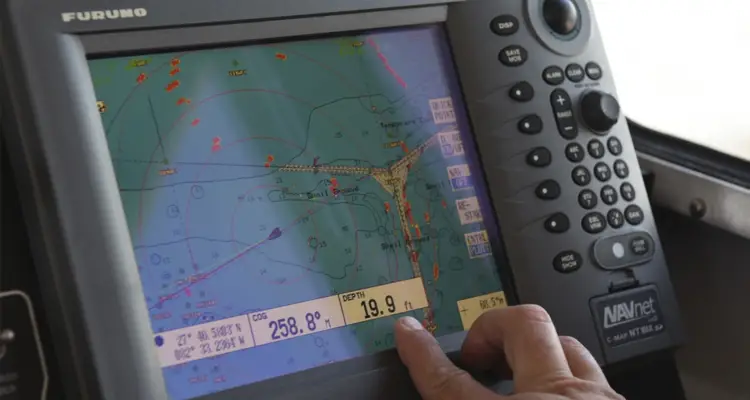
Automatic Identification System
Modern-day ships are equipped with several modern equipment and safety measures to ensure a smooth and successful voyage. These new techniques have emerged and evolved from years and years of study, research and experimenting. One such system is the Automatic Identification System or AIS. This article discusses the meaning of this term, the purpose and…
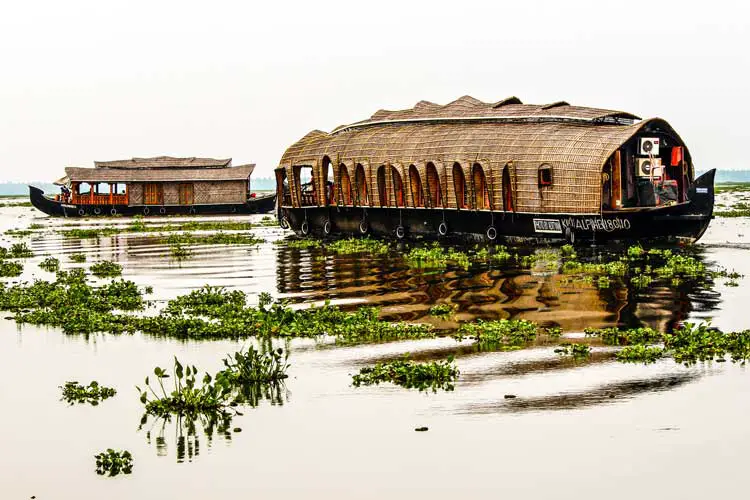
What Are Houseboats?
What Is A Houseboat? A houseboat as the name suggests is a boat that is constructed or modified to be used as a home. They are a result of a unique combination of housing and boating and are used for residential or recreational purposes. They are used as an alternate residency in many parts of…
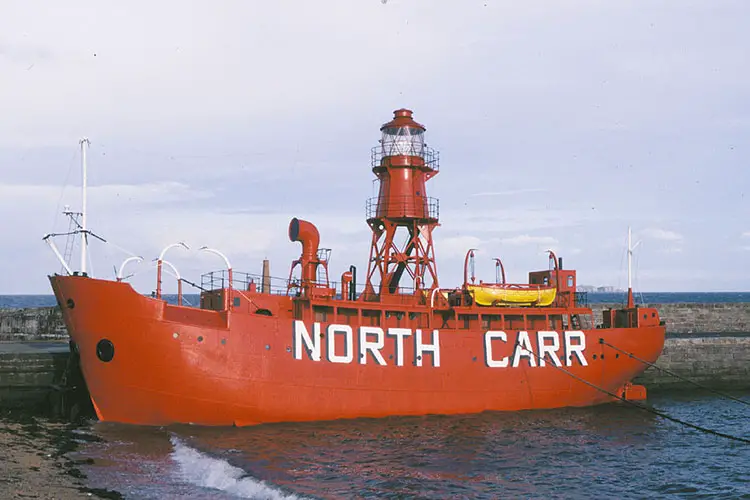
What Is A Lightship?
What is a Lightship? A lightship or a light vessel is a ship that can also operate as a lighthouse. These types of ships are used in waters that are too deep and where lighthouses cannot be constructed. Lightships play an important role in assisting other ships to navigate through waters. A lighthouse is a…
Leave a Reply Cancel reply
Your email address will not be published. Required fields are marked *
Save my name, email, and website in this browser for the next time I comment.
This website uses cookies to improve your experience. We'll assume you're ok with this, but you can opt-out if you wish. Read More
Sign up now for our WhatsApp newsletter and receive a FREE SVB set of playing cards!
- Spare parts
- SVB@Youtube
- Saved Guides
- My Skipper profile
- My boat on Portmaps.com
- General settings:
- Newsletter and messages
- NEW WhatsApp & SMS
- Compare list
Are you missing items that you have already placed in your shopping cart? Log in to see your saved items.
- Boat Safety Equipment
Navigation Lights on Sailing Yachts and Motor Boats

Navigation lights ensure the safety of everyone at sea. The Convention on the International Regulations for Preventing Collisions at Sea (IMO COLREG 72) precisely sets out the guidelines for navigation lights, i.e., displaying lights, their range (distance from which the light is visible), as well as how they should be constructed and assembled. Our guide is of interest to sailors and sports boats enthusiasts with boats up to 20 m in length.
Regulations and official certifications:
When must navigation lights be displayed, what are the regulations concerning the use of navigation lights at sea, how do i know that my lights are eu-compliant, what is a ce mark, how are navigation lights defined, minimum range of navigation lights:.
- From what distance must lights be visible?
- What lights are required for my boat?
What lights must be displayed on a sailboat or rowing boat with a motor?
What lights should i exhibit when at anchor, what lights should be displayed to show that a vessel is unable to manoeuvre.
- How do I indicate that my vessel has run aground?
Navigation lights – Conventional and LED:
What distinguishes led from conventional navigation lights.
- Replacement bulbs for conventional & LED lights
What are the advantages of LED navigation lights?
Switching from conventional to led navigation lights.
According to COLREGs part C, rule 20), navigation lights must always be used on board from sunset to sunrise or during the day if visibility is poor.
Please refer to the German Traffic Regulations for Navigable Maritime Waterways , §8 -10 and Preventing Collisions at Sea. Part C - Lights and Shapes. rules 20 - 31, and annexes I 1. - 14 for the exact wording.
NOTE: Vessels that are authorised to fly the German flag are generally only permitted to use approved navigation lights and sound signalling devices.
EU approval can be identified via the wheel mark symbol and the notified body number. BSH approved navigation lights (previously DHI) are marked with a model number (e.g., BSH/00/01/90).
However, even older lights with DHI approval that have already been installed maintain their approval, despite the changes made by the BSH.
In addition to the wheel mark symbol and German BSH approval, some lights are also approved by other countries, such as RINA (Registro Italiano Navale), MCA (Maritime and Coastguard Agency) and the USCG (United States Coast Guard). These are now recognised, provided the approval comes from the national approval body recognised in the country of origin.
National bodies whose accreditation is currently recognised in Germany:
The wheel mark symbol indicates approval of the Marine Equipment Directive (MED). This approval is valid for all EU member states, both for commercial vessels and recreational shipping.
0098 = Notified Body number (here 0098 = Germanischer Lloyd in Hamburg) 18 = year in which the mark is affixed, here 2018

- A CE mark is a symbol that must be affixed to a product by the manufacturer before it is sold on the European market. It indicates that the manufacturer is aware of the specific requirements for the product in question and that it fulfils the requirements of relevant European product directives. A CE mark does not supersede approval according to collision prevention regulations.
- Navigation lights are defined in detail by the International Maritime Organization (IMO), according to the International Regulations for Preventing Collisions at Sea, 1972 (COLREGs) Convention on the International Regulations for Preventing Collisions at Sea, 1972), in sections C and D. The following rules apply:
Which navigation lights are required on board according to IMO COL REG?
Definitions according to the 1972 International Regulations for Prevention of Collisions at Sea (COL REG 72):

1. Side lights for starboard and port
A green light on the starboard side and a red light on the port side, which shine from dead ahead in an arc of 112.5° aft to a point 22.5° abaft the beam (behind the beam) on either side of the vessel. On ships of less than 20 metres in length, the two individual sidelights may be replaced by a dual-colour combined light. This must be centrally located on the bow and stern axis.

2. Stern light
A white light mounted as close to the stern as possible and shines dead ahead in an arc of 135° (67.5° to each side). The mounting height should be aligned to the height of the side lights and should never be higher.

3. Three-colour light for sailing vessels (sailing lights)
On sail boats up to a length of 20 m, the side light and stern light can be combined into one three-colour light mounted on top of the mast. However, as soon as the sail boat's motor is engaged, the use of a three-colour light is no longer permitted. The rules for motor-powered vessels then apply.

4. Mast-head light
A white light placed over the centre line of the vessel and shines dead ahead in an arc of 225° (from straight ahead up to 22.5° more aft than crosswise to each side). The mounting height should be at least 1 m higher than the side lights. In the past, the mast-head light was also referred to as a steam boat light or steamer light, as it is only seen on ships that operate under engine power.

5. Signal light or all-round light
A light that shines in a complete circle of 360°. It may emit white, red or green light, depending on use. Examples of use: All sailboats and motorboats at anchor must exhibit a white anchor light . Ships over 12m in length must, if necessary, display vessel-in-distress lights (two red signal lights) placed at a vertical distance of at least 12 m. The distance between such lights must not exceed 1 m.
From what distance must navigation lights be visible?
The range indicates the distance from which the light can be seen. The minimum ranges of navigation lights are defined according to ship size as follows::
Best-seller Hella marine

Note: When sailing boats are powered by a motor, the rules for motorboats apply and not for sailboats. The tricolour light may then no longer be displayed.

Displaying lights for sailboats up to 20 m
1 x red port side light
1 x green starboard light
1 x stern light
Also allowed:
1 x red all-round light on or near the mast top
1 x green all-round light on or near the mast top

1 x 3-colour light

Sailing vessels under 7 m (dinghies or small sports boats)
If, due to their design, no modern lights can be fitted, sailing vessels under 7 m in length and vessels being rowed must always carry an electric torch or lantern showing a white light, ready to exhibit in sufficient time to prevent a collision.
1 x Electric light or a torch with white light

Motorised vessels over 12 m
Lights used must be either / or:
1 x white masthead light fore

1 x dual colour light

Motorised vessels under 12 m
Alternatively, motorised vessels under 12 m can exhibit the following lights:
1 x white all-round light

Motorised vessels under 7 m and 7 knots maximum speed (small motor boats, dinghies or inflatables):
Motorised vehicles under 7 metres and with a maximum speed of no more than 7 knots can display the following navigation lights: all-round lights, portside and starboard lights.
The following applies in accordance with German Traffic Regulations for Navigable Maritime Waterways (SeeSchStrO): If, due to their design, no lights can be displayed (e.g., dinghies), sailing vessels under 7 m in length and 7 knots maximum speed must carry an electric hand-held spotlight or a torch to prevent collisions in the dark.
Left: 1 x white all-round light, 1 x red port side light, 1 x green starboard light
Right: 1 x hand-held spotlight or torch
Best-seller Aqua Signal Conventional

Best-seller Aqua Signal LED

Provided no engine power is used, the rules for sailboats apply. Motor-sailing vessels must display a large black cone pointing downwards when sailing during the day or at good light.
For vessels travelling under sail or at rudder during darkness or at reduced visibility, the rules for carrying lights for motorised boats automatically apply. This then depends on the length of the boat.
By day with a black cone, tip pointing downwards.
Visual signalling equipment

Torches & Spotlights

How must navigation lights be mounted on board?
Navigation lights must be securely mounted perpendicular to the waterline. Mast-head lights and stern lights should both be placed above the keel line.
At anchor during daylight? This must be displayed with a black anchor ball.
If the vessel is anchored outside of an area of water known by the River and Shipping Police Authority as an anchorage and berth for small vessels, this must be indicated as follows:
A black ball by day, 1 x white all-round light at night

Marker Lights

If your boat is unable to manoeuvre*, this should be indicated as follows:
Stationary: 2 x red all-round light, 2 x black ball, one below the other (during the day)
Moving: 1 x red port side light, 1 x green starboard light, 1 x white stern light
* A vessel is described as if, due to exceptional circumstances (e.g., rudder failure or engine malfunction), it cannot manoeuvre as prescribed and therefore cannot avoid another vessel.

How do I indicate correctly that my sailboat or motorboat has run aground?
If your boat has run aground, this should be indicated as follows:
2 x red all-round light, 1 x white all-round light, 3 x black ball, one below the other (during the day)
Manufacturers that specialise in navigation lights such as Aqua Signal or Hella Marine supply a wide range of internationally approved navigation lights which work with conventional (with BSH bulb) or with permanently installed light-emitting semiconductor components (LEDs). The bulbs required for operation are an integral part of the approval. Replacement bulbs must also be certified so that approval / your insurance protection is guaranteed. Ships under 20 m: Stern and anchor lights require BSH-approved light bulbs with 10 watts, all other navigation lights 25 watts.
All series listed above with BAY15d sockets could alternatively be operated with a high-Power LED . The big advantage in doing so is that the LED is suitable for multiple voltages (10-30 V) and consumes just 3 watts during operation. Since the light colour, range of light or beam angle can vary depending on the housing, this light is NOT yet internationally approved.
Spare Bulbs - Conventional & LED

Energy consumption on sailing ships is, as ever, a topic of significant interest. This is especially true for blue-water sailors who like to sail longer distances at a stretch. The arguments for converting to LED technology are as follows:
- High energy savings due to the low power consumption
- Long lifespan (over 10,000 hours)
- MultivoltTM technology (10-30V) with greater tolerance to voltage peaks
- Compact and light housing constructions
- Waterproofed, hermetically sealed housings
- Maintenance free
When switching completely from conventional navigation lights to LED lights, lights with the BSH seal of approval / EU wheel mark meet all the requirements in terms of light colour (no risk of blue tint), range of light and beam angle, and that you are travelling in accordance with KVR.
Navigation lights with LED technology

Replacing your navigation lights is often easy to do as manufacturers usually use the same mounting points for LED lights or have an adapter plate for further use of existing drill holes:

Adapter plate

Share our guide on social media

Written by our SVB (technical) experts
Our SVB safety experts regularly carry out maintenance checks and tests on our safety products, such as life jackets, life rafts etc. They test products and base their recommendations on many years of experience and their own know-how.
- 2024 BOAT BUYERS GUIDE
- Email Newsletters
- Boat of the Year
- 2024 Freshwater Boat and Gear Buyers Guide
- 2024 Boat Buyers Guide
- 2024 Water Sports Boat Buyers Guide
- 2023 Pontoon Boat Buyers Guide
- Cruising Boats
- Pontoon Boats
- Fishing Boats
- Personal Watercraft
- Water Sports
- Boat Walkthroughs
- What To Look For
- Best Marine Electronics & Technology
- Watersports Favorites Spring 2022
- Boating Lab
- Boating Safety

USCG Navigation Lights Requirements
- By Boating Staff
- Updated: November 2, 2017
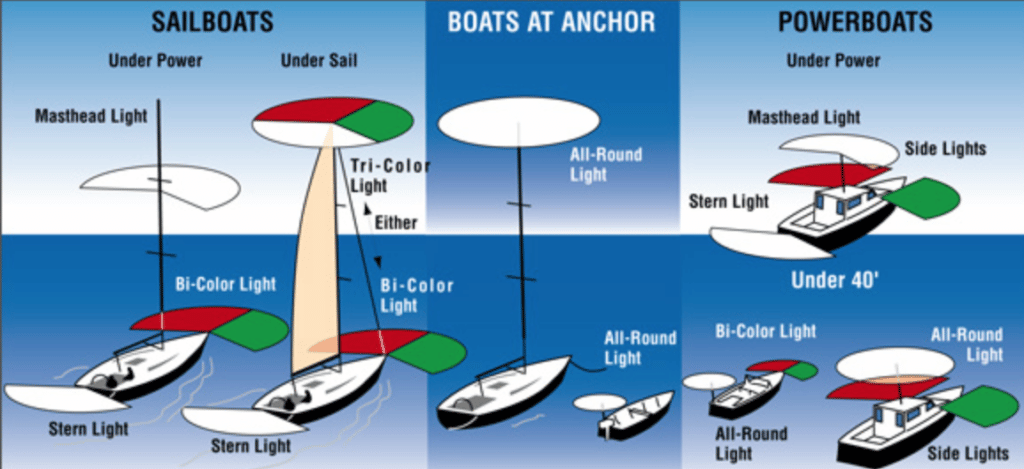
Powerboats under 12 meters (39.4 feet) in length must have separate or combined red and green sidelights covering 112.5 degrees and visible for 1 nautical mile. The white masthead light must cover 225 degrees, be 1 meter above the sidelights and be visible for 2 nautical miles. The white stern light must cover 135 degrees and be visible for 2 nautical miles, or you can substitute one 360-degree all-around white light. For larger boats, the sidelights must be visible for 2 nautical miles and the masthead light for 3 nautical miles.
Click here for complete USCG Recreational Boating Regulations.
- More: all aboard boats , Boating Safety , Boats , navigation lights
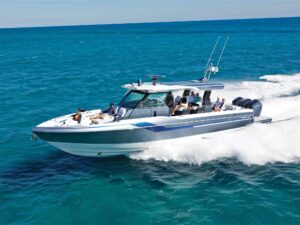
Boat Test: 2024 Formula 457 CCS
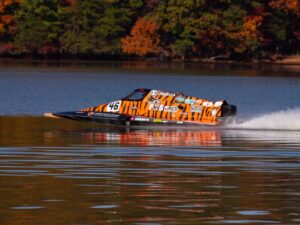
A New Electric-Powered-Boat Speed Record
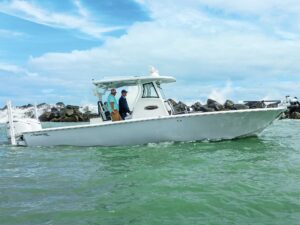
Boat Test: 2024 Tidewater 3100 Carolina Bay
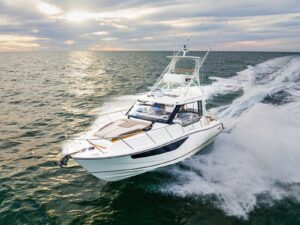
Boating On Board: Boston Whaler 365 Conquest
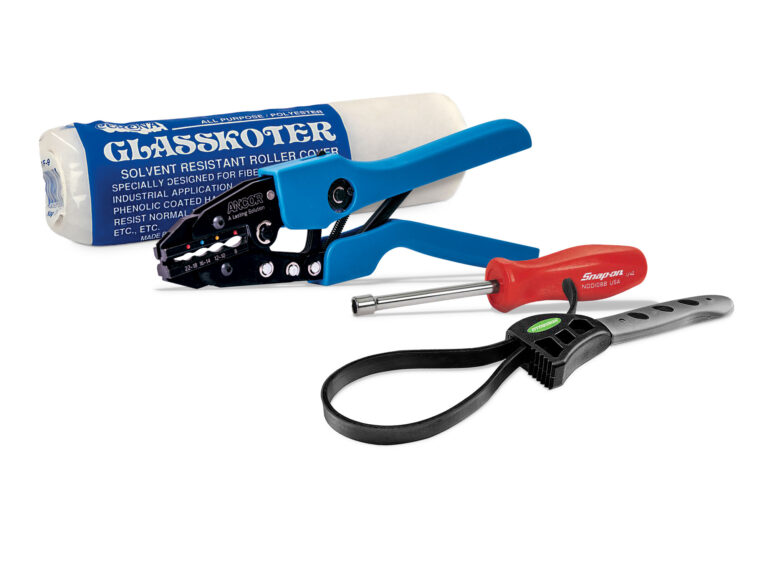
Six Tools for Spring Make-Ready
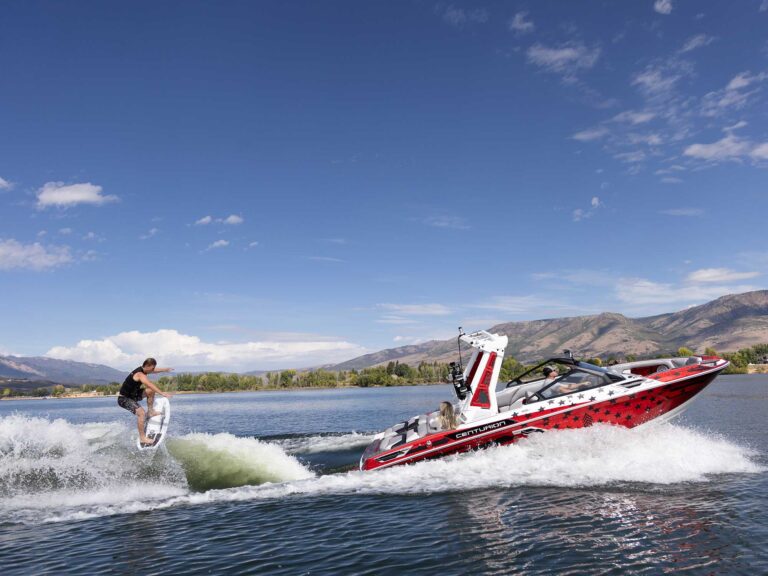
Tips for Shaping the Perfect Wake
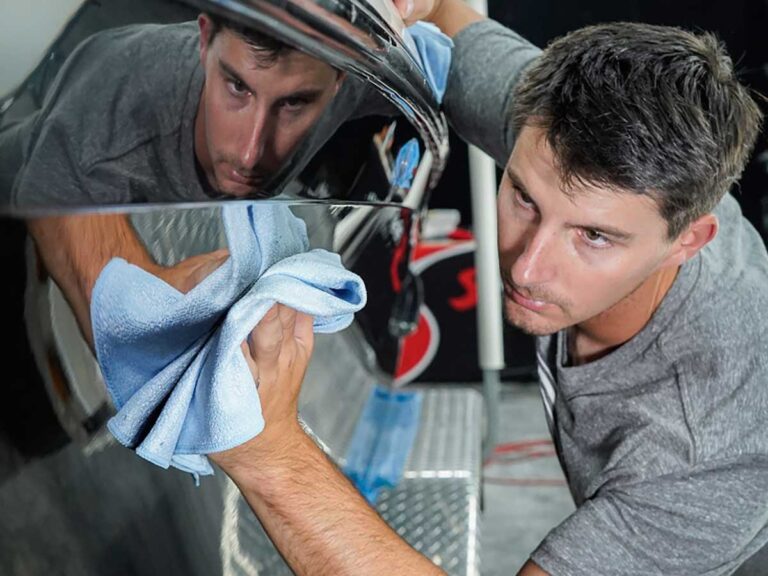
Eight Tips for Waxing Your Boat
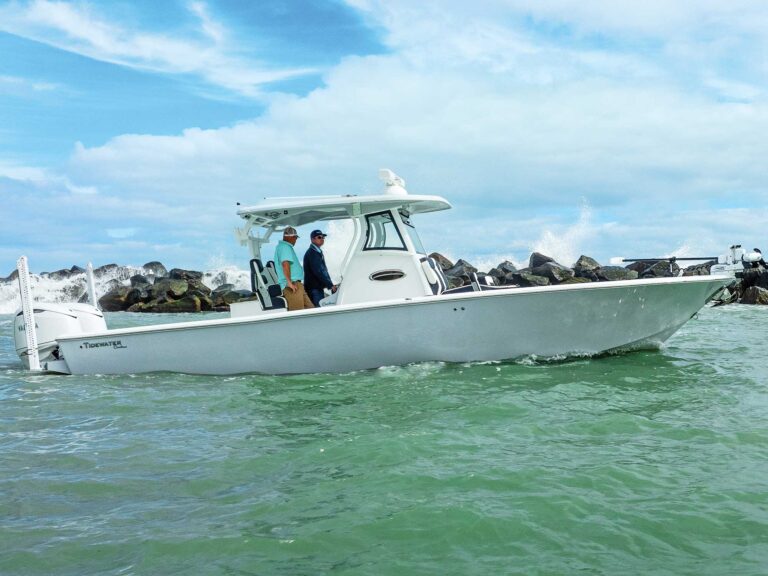
- Digital Edition
- Customer Service
- Privacy Policy
- Cruising World
- Sailing World
- Salt Water Sportsman
- Sport Fishing
- Wakeboarding
Many products featured on this site were editorially chosen. Boating may receive financial compensation for products purchased through this site.
Copyright © 2024 Boating Firecrown . All rights reserved. Reproduction in whole or in part without permission is prohibited.
Steaming Light on Sailboat: A Guide to Proper Usage
by Emma Sullivan | Aug 11, 2023 | Sailboat Maintenance

== Short answer: Steaming light on sailboat == A steaming light is a white navigation light fitted on the mast of a sailboat to provide visibility during low-visibility conditions. It is typically placed near the front side of the mast and angled downwards to indicate that the vessel is under power and moving forward. This light helps other boats identify and avoid collisions, ensuring safe navigation at night or in limited visibility situations.
Understanding the Purpose of a Steaming Light on a Sailboat: What You Need to Know
Have you ever been out on a sailboat and noticed a small light at the top of the mast? You might have wondered what its purpose is or why it’s necessary. Well, that little light is called a steaming light, and it plays a crucial role in ensuring safety and navigation on a sailboat . In this blog post, we will dive into the details of understanding the purpose of a steaming light on a sailboat.
To begin with, let’s clarify what exactly a steaming light is. A steaming light is a white-colored navigation light located on the front of the mast or near the bow of a sailboat. Its main function is to provide visibility to other vessels during low-light conditions or at night. This means that whether you’re sailing in foggy weather, dim lighting, or after sunset when natural visibility decreases, the steaming light will maximize your boat’s presence to prevent collisions with other boats.
So why is it specifically called a “steaming” light? The term “steaming” refers to sailing when using an engine rather than relying solely on wind power. When you are using your boat’s engine for propulsion instead of sailing with just your sails, it is known as “motoring” or “steaming.” The steaming light got its name because it primarily signifies that the vessel has powered propulsion engaged rather than utilizing only wind power.
Now that we know what a steaming light does and where it gets its name from let’s discuss more about its importance. One major reason for having this navigation aid onboard is compliance with international boating regulations and standards set by organizations like COLREGs (Convention on the International Regulations for Preventing Collisions at Sea). These regulations ensure safe navigation practices globally and require boats to display certain lights for visibility purposes both to avoid accidents and allow other captains to understand their intentions.
When operating under engine power, displaying only proper red (port) and green (starboard) sidelights can confuse other boaters, as these lights typically indicate the presence of a vessel under sail. To avoid such confusion, the use of a steaming light in conjunction with the appropriate sidelights clarifies that the boat is motoring and not just relying on its sails for propulsion.
Another important aspect to note about steaming lights is their distinct positioning on a sailboat . Typically, they are mounted at least one meter above the deck level to ensure maximum visibility. This height allows for unobstructed illumination, making it easier for other boaters to see your vessel from afar. It’s crucial to maintain this specific positioning to comply with regulations and maximize safety on the water.
In summary, understanding the purpose of a steaming light on a sailboat is essential for any sailor or boat owner. Its primary function is to provide visibility during low-light conditions or at night when using engine power instead of relying solely on wind power. By complying with international regulations and properly displaying navigation lights like a steaming light , you enhance safety by avoiding confusion between sailing and motoring vessels. So next time you’re out on the water after dusk or in foggy weather, remember the importance of that little but mighty steaming light atop your sailboat’s mast!
Step-by-Step Guide: How to Install a Steaming Light on Your Sailboat
Installing a steaming light on your sailboat might seem like a daunting task, but with the right guidance and a bit of patience, you’ll have it up and running in no time. In this step-by-step guide, we’ll walk you through the process of installing a steaming light on your sailboat, ensuring that you have a safe and well-lit vessel on your next sailing adventure.
Step 1: Gather the necessary tools and materials Before diving into the installation process, make sure you have all the tools and materials required. You’ll need a steaming light fixture, wires (preferably marine-grade), heat shrink tubing, electrical connectors, wire cutters/strippers, crimping tool, electrical tape, screwdrivers (flathead and Phillips-head), mounting brackets or screws if needed, and a drill with appropriate bits.
Step 2: Identify the ideal location for installation Finding the right spot for your steaming light is crucial as it needs to be clearly visible from all angles while ensuring it won’t interfere with other equipment or rigging. Typically, sailors prefer placing it at the masthead or near where the mast meets the deck.
Step 3: Prepare for installation Ensure that all power sources are disconnected before beginning any work. Next, carefully remove any existing fixtures or wiring from the chosen location (if applicable). If there’s already an ample power supply nearby (e.g., an existing navigation light circuit), tap into it to minimize additional wire routing.
Step 4: Mount the steaming light fixture If your chosen spot requires mounting brackets or screws for support, position them accordingly using suitable hardware. Ensure they are firmly secured to prevent any movement due to vibrations caused by sailing conditions. Attach the steaming light fixture securely to these brackets using screws provided with the fixture.
Step 5: Connect wires and ensure proper wiring configuration Strip off some insulation from both ends of each wire to be connected. Using heat shrink tubing, slide it over one end of each wire to ensure a clean finish once the connections are made. Connect the appropriate wires from the steaming light fixture to the power supply or existing wiring and secure them using electrical connectors. It’s crucial to follow a proper wiring configuration, so refer to the manufacturer’s instructions or consult a professional if needed.
Step 6: Test functionality and safety Once all connections are securely made, reconnect the power source and turn on your sailboat’s battery. Switch on your steaming light and verify that it’s functioning correctly. Check for any loose connections, flickering lights, or signs of overheating during this testing phase. If everything looks good, proceed to finalize the installation.
Step 7: Secure and protect the wires Using zip ties or cable clamps, neatly bundle and secure all wires along their path towards the power source or existing wiring nearby. This step is especially important as it prevents any accidental snagging or damage caused by movement while sailing.
Step 8: Add finishing touches To ensure long-lasting durability and protection against environmental factors (moisture, saltwater), add an extra layer of weather-resistant insulation tape around exposed wiring connections. This additional safeguard will help shield your newly installed steaming light from any potential issues that may arise due to harsh maritime conditions.
By following these step-by-step instructions carefully, you can install a steaming light on your sailboat like a pro! Not only will you be adding an essential safety feature to illuminate your vessel in low visibility situations but also enhancing its overall aesthetics for impressive nighttime sailing adventures. So don’t let darkness dampen your enthusiasm – take charge of your boat’s illumination and enjoy safe sailing every time!
Common FAQs About Steaming Lights on Sailboats: Answered!
Introduction: When it comes to sailboats, there are often many questions that arise about various aspects of their features and functionalities. One such area of curiosity is the steaming lights on these vessels . To shed some light on this topic, we have put together a list of common frequently asked questions (FAQs) regarding steaming lights on sailboats, along with their detailed answers. So without further ado, let’s dive into these queries and unravel the mysteries surrounding steaming lights!
Question 1: What are steaming lights? Answer: Steaming lights refer to a specific type of navigation light installed on sailboats . These lights are commonly found on the front or aft of a vessel and emit a white light that extends over a defined arc.
Question 2: Why are steaming lights necessary for sailboats ? Answer: The main purpose of steaming lights is to ensure the safety and visibility of sailboats while navigating in low visibility conditions or at night. By illuminating the boat from forward or aft, they help other vessels identify its position, direction, and whether it is underway.
Question 3: Are steaming lights always required to be displayed ? Answer: Yes, according to international maritime regulations (COLREGS), all mechanically propelled vessels (including sailboats) exceeding a certain length must display proper navigation lights during nighttime navigation or in times of restricted visibility. Steaming lights are an essential component of these required navigational signaling devices.
Question 4: Where should steaming lights be positioned on a sailboat ? Answer: Typically, steaming lights are mounted on either the front masthead or closer to the bow (foremost part) of the vessel . The exact positioning depends on the boat’s design and requirements outlined by local boating regulations.
Question 5: Can other colored lights be used instead of white for sailing at night? Answer: No, according to international standards, specifically Rule 23 of COLREGS, steaming lights on sailboats must emit a white color to maintain consistency and avoid confusion with other types of vessels. White lights also have the advantage of visibility at greater distances.
Question 6: Are there any rules regarding the brightness or intensity of steaming lights ? Answer: Yes, regulations exist concerning the luminous intensity required from steaming lights . However, these requirements differ depending on the length of the vessel and are specified in international maritime regulations or local boating guidelines. Sailors must ensure their steaming lights meet these specifications.
Question 7: Can steaming lights be used while at anchor or in port? Answer: No, steaming lights should not be used while a sailboat is at anchor or docked in a port. These lights are specifically designed to indicate that a vessel is underway. When anchored or moored, different lighting configurations, such as an anchor light or deck-level navigation lights, should be used instead.
Conclusion: Understanding the significance and proper usage of steaming lights on sailboats is crucial for both experienced sailors and newcomers to ensure boating safety. In this blog post, we have addressed some common questions about these navigation lights and provided detailed explanations for each query. By following international regulations and local guidelines regarding the positioning, color, brightness, and usage of these essential lighting devices, sailors can navigate their vessels confidently even in reduced visibility conditions. Remember, responsible sailing includes being knowledgeable about every aspect of your boat’s equipment – including its illuminating features!
Choosing the Right Steaming Light for Your Sailboat: Factors to Consider
Picture this: you’re sailing gracefully through the open waters, harnessing the power of the wind, when suddenly darkness descends upon you. The sun has set, and it’s time to rely on your trusty steaming light to guide your way. But wait! How do you choose the right one? Fear not, fellow sailors, for we are here to shed some light (pun intended) on this important decision. Here are some factors you should consider before picking out the perfect steaming light.
1. Regulations and Safety Standards: First and foremost, always adhere to regulations and safety standards set by maritime authorities. Different jurisdictions might have specific requirements regarding visibility range, color specifications, mounting heights, and more. Familiarize yourself with these guidelines to avoid unnecessary fines or safety hazards.
2. Visibility: Ahoy there! One of the primary purposes of a steaming light is to ensure that other vessels can see you while underway. Consider both the intensity of the light and its range. Opt for a light that boasts exceptional brightness without blinding nearby captains (we don’t want any sailors rubbing their eyes in confusion!).
3. Energy Efficiency: As responsible stewards of our oceans, sustainability should always be on our minds – even when it comes to choosing a simple steaming light. Look for LED lights as they consume significantly less power compared to traditional incandescent bulbs while providing excellent illumination throughout your journey.
4. Durability: When it comes to marine equipment, durability is essential since it may face harsh weather conditions such as intense sun exposure and heavy rainstorms – not to mention saltwater corrosion! Seek a steaming light specifically designed for marine environments; preferably made from strong materials like stainless steel or robust plastics.
5. Ease of Installation: Unless you’re an adept sailor who thrives on complex wiring tasks reminiscent of navigating through treacherous waters, selecting a steaming light that is easy to install and maintain is paramount. Look for lights that come with simple mounting options and clear instructions – nobody wants to be left in the dark (literally) while fumbling around with confusing installation manuals.
6. Compatibility: Your sailboat’s existing electrical system should be considered when choosing a steaming light. Ensure that the voltage requirements of your chosen light match those of your marine battery system. Additionally, check if the wiring connections are compatible for seamless integration.
7. Aesthetics: Ah, sailors are known for their keen sense of style! While aesthetics may not directly impact the functionality of a steaming light, many sailors take pride in outfitting their vessels with accessories that enhance its overall design. Consider opting for a sleek and modern design that complements the aesthetics of your sailboat while providing superior performance.
8. Value for Money: As much as we hate to admit it, costs play an important role in decision-making processes. Research different brands and models to find out which ones offer excellent value for money without compromising on quality or reliability. Remember, skimping on safety equipment isn’t just unwise; it could also turn into an expensive mistake down the line.
By considering these factors and conducting thorough research, you can confidently choose the right steaming light for your sailboat – ensuring safer navigation during both day and night expeditions. May your voyages always be illuminated by the perfect beacon, guiding you towards memorable adventures on the high seas !
Troubleshooting Tips for Maintaining your Steaming Light on a Sailboat
Maintaining the steaming light on a sailboat is essential for safe navigation, especially during low visibility conditions. This small but mighty light not only helps you see ahead but also signals your presence to other vessels on the water. However, as with any electrical equipment, issues can arise that require troubleshooting and maintenance. In this blog post, we will provide you with professional, witty, and clever tips to ensure your steaming light stays in top-notch condition.
1. Check the Basics: First things first – let’s start with the basics! Before diving into complex troubleshooting techniques, make sure to inspect the obvious factors that could lead to a malfunctioning steaming light. Check if it’s properly connected and securely fastened to avoid loose or faulty wiring connections—an easy fix that might save you hours of troubleshooting later!
2. Don’t Underestimate Corrosion: Ahoy there Captain! When it comes to maritime environments, corrosion is your worst enemy. The combination of saltwater spray and constant exposure can wreak havoc on electrical systems onboard; your steaming light is no exception! Regularly inspect the contacts and terminals for signs of corrosion or rust buildup. Use a brush or a fine-grit sandpaper to remove any unwanted visitors from these surfaces. Remember, a clean connection ensures optimal performance !
3. Fuse in Time Saves Nine: Some sailors tend to forget about fuses while troubleshooting their boat’s lighting system—don’t be one of them! The humble fuse protects your electrical system from potential overloads, shorts, and fire hazards caused by an unexpected surge in current flow . If your steaming light fails to illuminate even after checking wiring connections and corrosion issues, don’t overlook this vital component! Replace any blown fuses promptly according to their specifications.
4. Shine Bright Like a Pro: “A dim steaming light? Oh buoy!” Dim lights can affect visibility for both yourself and other mariners around you—so don’t compromise on this important safety feature! If your steaming light seems less luminous than usual, check for bulb degradation. Even a slightly loose bulb can significantly reduce its brightness. Tighten it up carefully or, better yet, replace it with a fresh and bright LED bulb that offers increased energy efficiency and longevity.
5. Put the Voltmeter to Work: When all else fails, put your trust in technology! The trusty voltmeter can help you diagnose electrical issues like a true sailor troubleshooter. Connect the meter to the terminals of your steaming light and measure the voltage supply when turned on. An insufficient voltage reading indicates wiring problems or potential battery drain issues that need further inspection.
6. Beware of Murphy’s Law: Ahoy there Landlubber! When troubleshooting any onboard issue, always keep Murphy’s Law in mind: “Anything that can go wrong will go wrong.” That’s why having spare parts like bulbs, fuses, and even extra wire connectors is essential for sailboat maintenance. Preparation is key when cruising on the open water !
7. Seek Help from Fellow Sea Dogs: Remember, you’re not sailing alone in this boat—a vast community of seasoned sea dogs is out there ready to lend a helping hand! Don’t hesitate to consult online forums or reach out to fellow sailors who might have encountered similar issues before. They may share their witty anecdotes and clever solutions that could solve your steaming light troubles faster than you think!
At the end of the day, maintaining your steaming light is not just about complying with maritime regulations; it’s about ensuring safe passage for both yourself and others on the waterways. By following these troubleshooting tips – from checking connections and addressing corrosion to involving technology like voltmeters – you’ll be able to maintain an illuminated path amidst challenging maritime conditions.
So set sail confidently knowing that even if darkness falls upon you (figuratively or literally), you’ll be well-prepared to troubleshoot and maintain your steaming light like a true professional sailor.
Don’t Set Sail Without It: The Importance of a Functional Steaming Light
When embarking on a sailing adventure, it’s crucial to ensure that every aspect of your vessel is in impeccable condition. From the sails to the rudder and everything in between, one essential component that often goes unnoticed is the steaming light. This small yet mighty fixture plays a significant role in ensuring both your safety and that of other sailors out on the water. In this blog post, we will explore why having a functional steaming light should never be overlooked when setting sail.
Firstly, let’s understand what a steaming light actually is. Mounted on top of the mast or at its front, the steaming light serves as an all-around white navigation light for boats under power. Its primary purpose is to help you stay visible to other vessels nearby by indicating your direction of travel at night or during periods of diminished visibility such as fog or heavy rain.
Now, you may be wondering why this seemingly inconspicuous light deserves so much attention. Well, think about it – imagine sailing through dense fog without a working steaming light! Without this beacon guiding your path, not only are you jeopardizing your own safety but also putting fellow seafarers at risk by refusing to comply with maritime regulations.
Additionally, navigating harbors and congested waterways becomes an even greater challenge without an operational steaming light. Picture yourself approaching a bustling marina late into the evening; by illuminating your boat’s foredeck with its bright white glow, the steaming light acts as a signal for others around you to be cautious and respect your right of way. This simple yet effective communication tool prevents accidental collisions and fosters harmony among boaters sharing busy waters.
But if safety isn’t reason enough to prioritize a fully functioning steaming light before each voyage, consider this: Mariners have an inherent responsibility to adhere to international maritime regulations set forth by bodies such as the International Maritime Organization (IMO). These regulations explicitly state that every vessel under power must display a white steaming light while underway during hours of darkness or limited visibility. By neglecting this requirement, you not only risk severe penalties but also jeopardize your reputation as a responsible boater.
Now that we understand the importance of a functional steaming light, it’s essential to keep it well-maintained and regularly inspected. After all, there’s nothing worse than setting sail only to have your navigation light fail at the most inopportune moment. Inspecting the wiring, replacing any worn-out bulbs, and ensuring proper alignment are simple steps that should form part of your pre-departure routine.
Remember, when it comes to sailing, “Don’t Set Sail Without It: The Importance of a Functional Steaming Light.” This unassuming yet crucial piece of equipment acts as both an indispensable safety feature and a responsible adherence to maritime regulations. So, before you embark on your next voyage, take the time to ensure that your steaming light is functioning optimally – after all, smooth seas start with being visible and considerate towards fellow sailors!
Recent Posts

- Sailboat Gear and Equipment
- Sailboat Lifestyle
- Sailboat Maintenance
- Sailboat Racing
- Sailboat Tips and Tricks
- Sailboat Types
- Sailing Adventures
- Sailing Destinations
- Sailing Safety
- Sailing Techniques
- Members Forum
- Log In / Create Account
Navigation Lights at Night
by Harbor Sailboats | Dec 4, 2020 | Blog | 1 comment

Great article! Boat lights are the means of communication between sailing vessels. These lights are also a tool to let my presence known even from a distance.
Submit a Comment Cancel reply
You must be logged in to post a comment.
Latest Blog Posts
- Sailing Lessons in San Diego
- Water in the Bilge
- Bow Standing
- Gear then Steer
- 2024 Club Flotilla- BVI’s
- Upcoming Course Schedule
- Testimonials
- Get a Conservation ID
Sailboat Lights
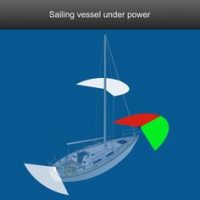
Sailboat Lights can be confusing and usually need some explanation.
Common Questions:
Is the tri-color light all I need when under power? Are the red and green lights at the top of the mast all I need? Am I supposed to turn any of these off? How then do I let others know I am under power? If you are under power, you of course need your mast head light illuminated, correct? (As seen here on the left). What if there are no pulpit or stern lights on your vessel? Shouldn’t you always use your mast lights? This is confusing!
Let’s talk it through:
Mast head lights can also be seen on power boats. Take a look at this image shown in the rules. It shows a power-driven vessel longer than 50 meters using two mast head lights.

Here is the definition of a mast head light in the rules:
A “Masthead light” means a white light placed over the fore and aft centerline of the vessel showing an unbroken light over an arc of the horizon of 225 degrees and so fixed as to show the light from right ahead to 22.5 degrees abaft the beam on either side of the vessel.
Note: It does not say the light must be at the top of the mast.
What is the tricolored light for?
Well, it is at or near the top of the mast and is for sailing vessels less than 20 meters or 65.5 feet in length. It is an optional alternative to having the lights down on the hull or pulpits. The tri-color light at the top of the mast faces a white light to the aft 135 degrees plus red from directly forward around to port 112.5 degrees and a green light directly forward and around to starboard 112.5 degrees.
This makes up 360 degrees and meets the requirement for a sailboat sailing .
So, when the sailboat turns on its engines it must also, in addition to the tri-color light at the top of the mast , display a white light 225 degrees facing forward. You can call this light whatever you’d like but it must exist. Now these particular white lights that we preferably call mast head lights , shall be visible from 6 miles. Note: It does not mean they have to be at the top of the mast. On power vessels they are typically at the top of the mast because that is what the mast is for.
Here is a sailing vessel under sail using a tricolored light. There is no forward-facing white light, like in the upper picture, so we know it is under sail.

To clarify, on a sailboat less than 50 meters in length, a white under power mast head light can be just up the mast anywhere. That is to say that it’s not part of the tri color. It is white and faces forward 225 degrees and indicates a sailboat is under power.
Where the confusion lies:
You also might be confusing the term mast head light with the two all-around red and green lights at the top of the mast. These are not mast head lights. They can be used in addition to the hull or pulpit mounted red, green, and white. A sailing vessel cannot display a top of the mast tricolored light AND the two all-around red and green at the top of the mast. Above all, the mast head is white 225 deg forward facing to be used under power only.
Pictured, the Vessel on the left is utilizing the optional two all-around red and green lights. Subsequently, this states that it is under sail or underway and not under engine power.
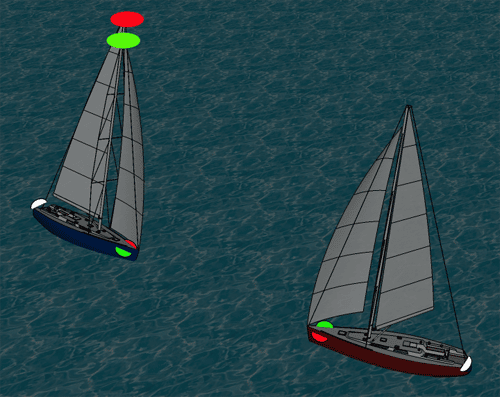
To further understand this picture, here are the rules as stated:
Rule 25 – Sailing Vessels Underway and Vessels Under Oars
(a) A sailing vessel underway shall exhibit:
(i) sidelights; (ii) a stern light
(c) A sailing vessel underway may, in addition to the lights prescribed in Rule 25(a), exhibit at or near the top of the mast, where they can best be seen, two all-round lights in a vertical line, the upper being red and the lower green, but these lights shall not be exhibited in conjunction with the combined lantern permitted by Rule 25(b).
In Conclusion:
You can further investigate using the United States Coast Guards book on Navigation Rules… NavRulesAmalgamatedwAnnexes.pdf (uscg.gov)
We are proud to discuss navigation lights in our Public Course please visit our Schedule any time. We teach all of our classes live in a virtual setting
NASBLA 2022 Accomplishments
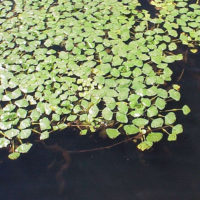
Clean Drain and Dry
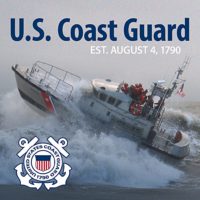
United States Coast Guard

Boating Tips for Beginners
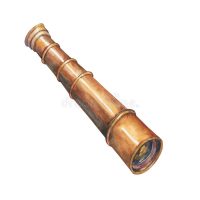
Keeping a Lookout
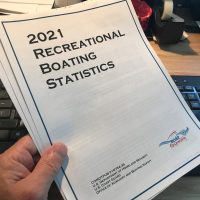
2021 Boating Accident Report Notables
- New Sailboats
- Sailboats 21-30ft
- Sailboats 31-35ft
- Sailboats 36-40ft
- Sailboats Over 40ft
- Sailboats Under 21feet
- used_sailboats
- Apps and Computer Programs
- Communications
- Fishfinders
- Handheld Electronics
- Plotters MFDS Rradar
- Wind, Speed & Depth Instruments
- Anchoring Mooring
- Running Rigging
- Sails Canvas
- Standing Rigging
- Diesel Engines
- Off Grid Energy
- Cleaning Waxing
- DIY Projects
- Repair, Tools & Materials
- Spare Parts
- Tools & Gadgets
- Cabin Comfort
- Ventilation
- Footwear Apparel
- Foul Weather Gear
- Mailport & PS Advisor
- Inside Practical Sailor Blog
- Activate My Web Access
- Reset Password
- Customer Service

- Free Newsletter

Ericson 34-2 Finds Sweet Spot

How to Sell Your Boat

Cal 2-46: A Venerable Lapworth Design Brought Up to Date

Rhumb Lines: Show Highlights from Annapolis

Solar Panels: Go Rigid If You have the Space…

Leaping Into Lithium

The Importance of Sea State in Weather Planning

Do-it-yourself Electrical System Survey and Inspection

When Should We Retire Dyneema Stays and Running Rigging?

Rethinking MOB Prevention

Top-notch Wind Indicators

The Everlasting Multihull Trampoline

What Your Boat and the Baltimore Super Container Ship May Have…

Check Your Shorepower System for Hidden Dangers

DIY survey of boat solar and wind turbine systems


What’s Involved in Setting Up a Lithium Battery System?

The Scraper-only Approach to Bottom Paint Removal

Can You Recoat Dyneema?

How to Handle the Head

The Day Sailor’s First-Aid Kit

Choosing and Securing Seat Cushions

Cockpit Drains on Race Boats

Re-sealing the Seams on Waterproof Fabrics

Safer Sailing: Add Leg Loops to Your Harness

Waxing and Polishing Your Boat

Reducing Engine Room Noise

Tricks and Tips to Forming Do-it-yourself Rigging Terminals

Marine Toilet Maintenance Tips

Learning to Live with Plastic Boat Bits
- Safety & Seamanship
RAM Lights for Sailboats
A search for a brighter anchor light yields a versatile surprise..
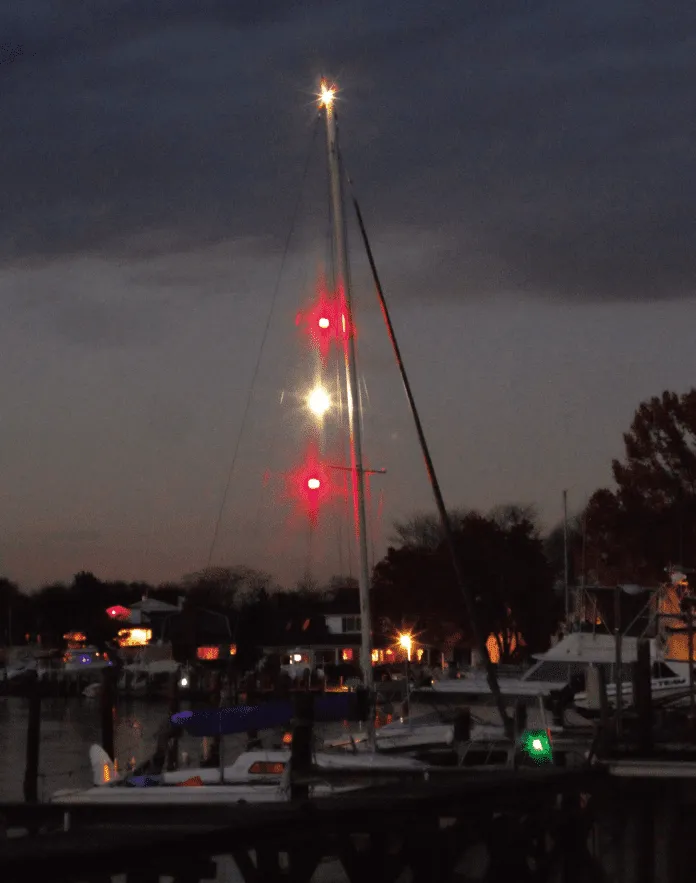
We have the minimum required lights, including running lights for sailing and motoring, and an anchor light. We might even have an electronic distress signal (“ Distress Flares Go Electric, ” June 2021). But do we have lights for rare navigation lighting situations, such as restricted ability to maneuver (RAM) or not under command (NUC)?
Ships, fishing boats, tugs, and dive boats are just some of the vessels that have masts dedicated for lights to alert nearby ships of their status, and to signal situations that might prevent them from maneuvering to avoid collision. Relatively few sailors have a means of showing all the specialized lights that might apply to sailboats. Should we?
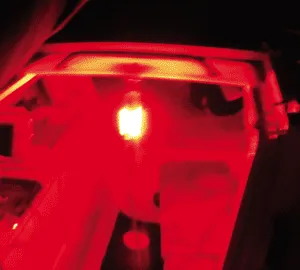
An anchor light is not for drifting, using a sea anchor, or any situation where you are not made fast to the ground. Flashing lights are only for distress. Thus, lighting and day shapes for a few additional navigation situations deserve discussion.
RESTRICTED ABILITY TO MANEUVER (RAM)
The lights for this situation are a vertical row of three lights, red/white/red, spaced 1 meter apart. The day signal is a ball/diamond/ball. RAM suggests that the motion of the boat will be predictable. A boat with divers in the water, hove to, or towing a drogue would be considered a RAM.
NOT UNDER COMMAND (NUC) DAY SHAPES AND LIGHTS
A vertical row of two red lights indicates the skipper has no control over motion, perhaps because of a broken rudder. Any motion, including drifting, qualifies as NUC. The day signal is two balls.
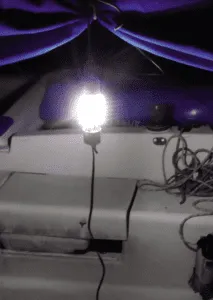
A day flag (either the blue and white “alpha” flag, or red with white diagonal stripe in the US) is required by law or regulation in the US and many countries. The divers are to stay within 25 yards (varies by state) when near the surface and boaters are to stay 300 yards from the flag (100 yards in a marked channel). No divers? Take the flag down. (Some states permit a flag painted on the side of dive boats).
At night a dive boat is considered restricted in its ability to maneuver (RAM), and the required lights are red/white/red, one meter apart in a vertical line. If the boat is drifting, running lights are also required, and if anchored, an anchor light is still required.
SEA ANCHOR OR DROGUE
Just like a dive boat that is drifting, a boat dragging a sea anchor or drogue needs to show running lights and RAM lights. Running with a drogue in heavy weather can be a matter of speed control and easing the motion, or survival. In the first case your ability to change course is limited, and you have very little control over the vessel’s speed. In the latter case you have no control over speed or course, but the motion of your vessel will be predictable.
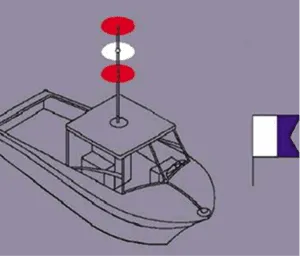
PROPER USE OF NUC INDICATORS
A boat with steering failure, dismasting, or some other situation that makes it impossible to control is considered not under command (NUC). A rudderless boat may randomly tack, circle, or speed up and slow down. Its motion is unpredictable. The day shapes and lights for this situation are not for sleeping or leaving watch, only for a boat that cannot be controlled.
COLREGS AND LIGHTS
A discussion of the Collision Regulations (COLREGs) regarding the above situations is best carried out with the rules at hand. The Coast Guard version, which includes U.S. inland rules as well as international rules, is available online ( www.navcen.uscg.gov/pdf/navrules/navrules.pdf ). Here are just a few excerpts relevant to lights and shapes for sailboats.
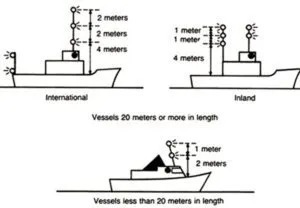
WHAT IS RESTRICTED ABILITY TO MANEUVER?
Definitions for a boat that is restricted in its ability to maneuver are in Rule 3 of the COLREGs.
(g)The term vessel restricted in her ability to maneuver means a vessel which from the nature of her work is restricted in her ability to maneuver as required by these Rules and is therefore unable to keep out of the way of another vessel. The term vessels restricted in their ability to maneuver shall include but not be limited to: (i)a vessel engaged in laying, servicing or picking up a navigation mark, submarine cable or pipeline; (ii)a vessel engaged in dredging, surveying or underwater operations; (iii)a vessel engaged in replenishment or transferring persons, provisions or cargo while underway; (iv)a vessel engaged in the launching or recovery of aircraft; (v)a vessel engaged in mine clearance operations; (vi)a vessel engaged in a towing operation such as severely restricts the towing vessel and her tow in their ability to deviate from their course.
SLEEPING UNDER SAIL OR UNDER BARE POLES
An unattended helm is not allowed under COLREGs. This is spelled out in Rule 5.
Every vessel shall at all times maintain a proper look-out by sight and hearing as well as by all available means appropriate in the prevailing circumstances and conditions.
Rule 37 covers distress signals.
When a vessel is in distress and requires assistance it shall use or exhibit the signals described in Annex IV of these Rules (33 CFR part 8) to illuminate her decks.
The accepted signal is a strobe flashing 50-70 times per minute. Sailors should also review also Rule 36, which states that any light used to attract the attention of another vessel cannot be mistaken for any aid to navigation. The rule also advises that the use of high intensity intermittent or revolving lights shall be avoided.
VERTICAL SPACING
Vertical spacing of lights is covered in Annex I. For boats less than 20 meters in length, the vertical row of lights must be greater than 2 meters above the uppermost continuous deck, spaced one meter apart, and be visible in all directions (no more than 6 degrees may be blocked by mast). For boats greater than 20 meters, the lights must be 4 meters above the deck and the spacing must be 2 meters (see illustration 2, page 18).
EXTRA LIGHTS
Rule 30 deals with extra lights in subsection (c):
A vessel at anchor may, and a vessel of 100 meters and more in length shall, also use the available working or equivalent lights to illuminate decks.”
FLORIDA DIVER LAW
Florida gets specific regarding divers. Not only are lights required at night, but a flag must be displayed. Interestingly, the specified flag differs from the international flag, which is the blue and white “Alpha” signal flag. According to Section 327.331 of Florida code:
(c) “Divers-down flag” means a flag that meets the following specifications:
1. The flag must be square or rectangular. If rectangular, the length must not be less than the height, or more than 25 percent longer than the height. The flag must have a wire or other stiffener to hold it fully unfurled and extended in the absence of a wind or breeze.
2. The flag must be red with a white diagonal stripe that begins at the top staff-side of the flag and extends diagonally to the lower opposite corner. The width of the stripe must be 25 percent of the height of the flag.
3. The minimum size for any divers-down flag displayed on a buoy or float towed by the diver is 12 inches by 12 inches. The minimum size for any divers-down flag displayed from a vessel or structure is 20 inches by 24 inches.
4. Any divers-down flag displayed from a vessel must be displayed from the highest point of the vessel or such other location which provides that the visibility of the divers-down flag is not obstructed in any direction.
(2) All divers must prominently display a divers-down flag in the area in which the diving occurs, other than when diving in an area customarily used for swimming only.
A black ball displayed where it is visible during they day indicates that a boat is at anchor. Use of this day shape for anchoring varies with the region, but in most of the U.S. no one uses them, few look for them, and most wouldn’t recognize it for what it is. Rules for smaller boats vary. In the U.S., boats less than 7 meters are exempt. Nevertheless, displaying a black ball makes sense near channels, so ships to determine your navigation status (anchored vs. underway) at a great distance. COLREGS specifies a ball with a minimum diameter of 2 feet, with exceptions.
For vessels of less than 20 meters in length, shapes of lesser dimensions but commensurate with the size of the vessel may be used, and the distance apart may be correspondingly reduced.
CONCLUSIONS
If you carry a sea anchor or drogue, have ever considered diving at night, or embark on single-handed voyages, making yourself both more visible and communicating your navigation status is smart. We don’t understand why hoistable light systems for recreational boaters is not available, so we’ve offered some do-it-yourself ideas in this report.
When it comes to lights for special situations like night diving or when the boat is disabled, recreational boats need temporary options that cost less and require little power. We found nothing practical that met our basic criteria for contingency use on sailboats. If you know of one, you can email us at [email protected] . These are all the lights that we found:
AQUASIGNAL HOISTABLE LIGHT
Aquasignal Series 40 hoistable lights. Similar to standard series 40 lights, these are 8 inches tall, 3 inches in diameter, and fit 25W incandescent bulbs (no LED option). Rigged as a red/white/red RAM light, they use 75 Ah of power each night, an unacceptable amount for many cruising boats. The cost is also steep, at $120 each ($360 total).
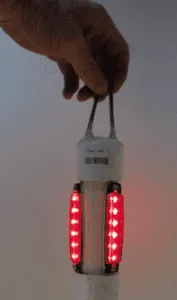
PERKO HALYARD MOUNT
The Perko halyard mount navigation lights are similar to the Aqua Signal lights, but they are discontinued, and we found no replacement. They cost about $85 ten years ago.
PRACTICAL SAILOR DIY LIGHT
Our DIY RAM light is based on the DIY anchor light modules but substituting red LEDs for white. They are weather proof, vibration resistant, meet the Coast Guard requirement for 3 mile visibility, and because the lights have a 120-degree vertical arc of visibility, full visibility is maintained even as a boat rolls heavily. The red version is slightly less bright than the white version, though it still meets the standard. You could, of course, mount four LED strips to make the red version brighter; there is enough room.
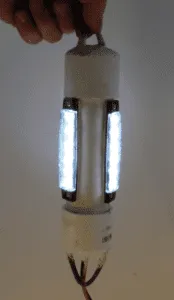
We considered adding switches, allowing a single unit to show a single white (anchor), red/white/red (restricted ability to maneuver) or two red (not under command), but decided that introduced additional failure points for options that would very seldom be used. Instead, we made the system modular, and you hoist only the components you need. They are chained together with cord/line extensions as needed. The cord/line extension is a 30-inch Dyneema strop with an eye in each end (one-meter spacing is required, and the light units are 10 inches long). Cable ties firmly attach a 24-inch 2-pin extension cord. One end of the strop is secured with a luggage tag hitch and the other with a screw link or shackle.
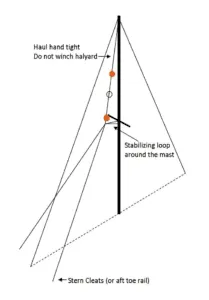
Our design for a DIY anchor light/RAM light is based on three white LED road trailer clearance marker lights, available for less than $1.50 per unit when purchased in packs. They meet the visibility requirements for boats of all sizes because they are designed to meet EU and US truck clearance light brightness requirements, which are significantly greater than those required for navigation lights. They are low-profile, weatherproof, and resistant to impact and vibration.
We mounted the lights around an 8-inch length of 1 ¼-inch PVC pipe; a single 5/16-inch hole passes the wires, two screws attach it in place, and it is sealed in place with a generous application of polyurethane caulk (we used Sika 291). The leads are coupled to a common 12V SAE 2-pin extension cord. Remember, LEDs are sensitive to polarity, so keep the positive and negative straight and used polarized plug connectors. The current draw is low enough (0.09 amps or 2.2 Ah per 24 hours) that we skipped the photo-electric cell that would turn it on and off automatically.
STEP BY STEP
1. Cut 6 ½-inch length of 1 ¼-inch schedule 40 PVC pipe.
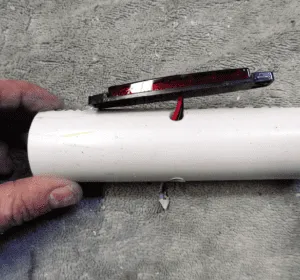
2. Drill three x 5/16-inch holes in the side for the light’s wires (Photo 1). Fit should not be too tight—you don’t want to pinch the wires. The holes are centered between the ends and spaced around the pipe 120 degrees apart. An easy way to mark for drilling is to wrap a sheet of paper around the pipe and cut at exactly one circumference length. Fold the paper into thirds, mark the folds, and wrap again. The folds will be 120 degrees apart and in line vertically, ready for marking
3. Drill holes for the mounting screws. Machine screws about ½-inch long are preferred; they won’t stick in far and they won’t cut the wire insulation. No need for nuts. Just drill holes 1/64-inch smaller than your screws, and they will self tap in the soft plastic.
4. Insert the wires through the center holes, apply sealant around each hole and down the center of the light strip, and screw them down. It is tempting to apply the sealant first, but then inserting the wires is a mess.
5. Wipe up the excess sealant. It’s a mess. You could mask around the holes for a neater finish.
6. Prepare the top cap (white anchor light-only). Drill two 3/16-inch holes in the cap, insert 10 inches of 3/16-inch Dyneema to form a loop, securing the ends with stopper knots. Apply sealant inside and out.
7. Prepare bottom cap and top cap of RAM modules. Same as Step 6, but add about 5/16-inch to center hole, to accommodate the plug pigtail.
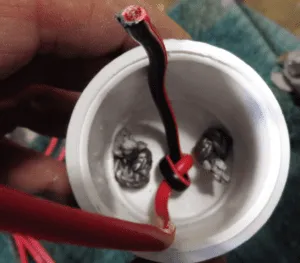
8. Thread the plug pigtails through the bottom cap hole and knot inside (Photo 2).
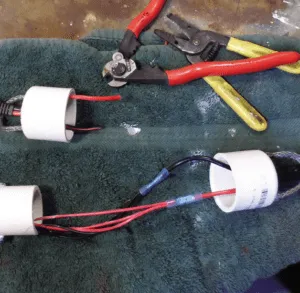
9. Twist the leads together and crimp to the pigtails (Photo 3). Be sure to strip enough insulation to allow for several twists. LEDs are polarity sensitive, so connect black-to-black (Photo 4). Seal the union with adhesive-lined heat shrink. Good fittings will have enough adhesive to fill the gaps between the three leads. The three leads, twisted together, should be about 14-16 AWG. RAM modules should have double-plug leads, one through the top and one through the bottom, so that they can be chained together.
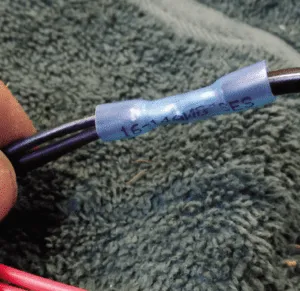
10. Note that although all 2-pin plugs appear identical, there is a distinct male and female. The male plug has the ground (black) exposed, so that accidental contact with a grounded surface, like a mast or engine, does not cause a short. Each light module must contain either a female plug (anchor light only) or one of each (RAM modules), so they can be chained together. Mark each module with an up arrow, or you will be frustrated when you plug in the wrong end and it doesn’t light.
11. Seal the Dyneema line and the pigtail into the bottom cap, inside and out.
12. Glue on both end caps on with PVC cement. The tensile strength of each unit exceeds 1,000 pounds (we tested them), so a string can safely be hauled as tight as hand tension allows.
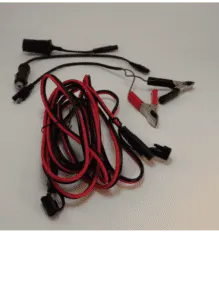
13. Prepare the supply cord. For the emergency anchor light we chose an 8-foot extension cord with SAE 2-pin connectors. We have three convenient outlets for this connector. We can plug it in just in front of the mast, in the cockpit, or in the cabin. In a pinch, you can rig a fused lighter plug directly to a battery (Photo 5), but lighter plugs are notoriously unreliable on boats, so this is temporary. As a supplemental harbor anchor light, we hoist the light 6 feet above the deck; at this level it is visible to nighttime dinghy operators and also lights up the deck. We can also extend with standard 2-pin extension cords. If the light is to be used as part of a RAM light system, the cord is shortened to 6 inches, so that it can be used as a module. Red light modules are the same as the anchor light module, except red LED marker lights are used.
14. Rig using non-stretch line (a halyard is good for the top) to reduce swinging. In wild weather, reduce swing by rigging the bottom line as a bridle that secures to the port and starboard toe rails (see Image 4). To prevent fore-aft swinging, add a loop (about 30 inches long) attached to the bottom light and around the mast, and raised to a point just below the spreaders. The bridles should be led aft and outboard. The lights must be pulled several feet away from the mast to keep the blind spot less than 6 degrees. The lights will hang at a slight angle, but this is not a big deal. In our case, the mast is raked sufficiently to serve this purpose. There is no need to pull the lights to the masthead, although they should be high enough to be visible above the swell.
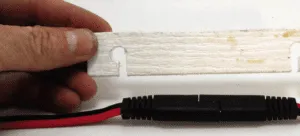
15. Prepare cord locks, if desired (Photo 6). The SAE plugs were designed for trailer wiring and the high friction fit is very unlikely to pull apart. But you can add locks for more security, and they take only a few minutes to make. The holes in the locks are 1/16-inch larger than the widest cord diameter. The slot is just wide enough to pass the narrowest dimension. The spacing is about 3/8-inch longer than the length of the closed plug pair. The strip can be either 3/16-inch HDPE or 1/8-inch aluminum, or fiberglass. It’s width is about 1 inch (aluminum or fiberglass) or 1 1/4-inches (high density polyethylene). Smooth the edges to avoid damaging the wire insulation.
The white light makes a useful cockpit and bilge work light. It’s waterproof. The red lights can be hung in the cabin or cockpit for vision-safe night lighting, although you still don’t want to look directly at the light (see “ Are Chart Lights Steering Us Wrong ,” PS October 2020).
Caps. $ 2 x 1.57 = $3.14
6.5” pipe = $0.70
LEDs = Three white side marker lights (6 LEDs each), 3 x $2.12 = $6.36
Assorted wire and sealant = $4
Cord = $4.20
Rope = $0.40
Total = $18.80
Since our August 2021 review of deck connectors (“ Watertight Connector Test ”), we’ve converted our F-24 test boat to SAE 2-pin connectors for many applications, including tiller pilot, mast lights, and utility cockpit connections. We like the price and widespread availability of the components, but the big selling point is easy interchangeability and ruggedness. For example, we can plug the emergency anchor lights and RAM lights into the mast base plug, the tiller pilot plug, a cabin plug, the cockpit plug, or straight to the battery with clips. Same with our utility washdown/emergency sump pump; we can plug it in wherever needed, just like appliances at home.
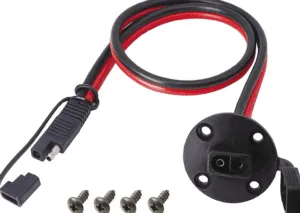
All of this applies equally to 4-pin connectors. They can be the better answer if you need more power to control more things. We’ve used 4-pin connectors for connections at the mast base for trailer boats.
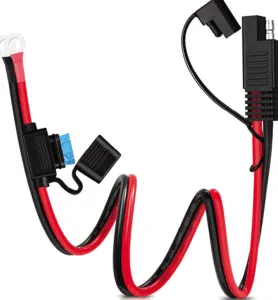
The exposed pin should be ground phase to reduce the risk of shorts. As long as the exposed pin is ground and the adjacent pin is power, 2-pin plugs can also be inserted into 4-pin sockets. Grease exposed ends with Tefgel or Green Grease twice per year (every few years inside the cabin). Keep the caps on when not in use so they don’t attract dirt and to cover the ground pin.
You will have to splice the wire tails. Crimping and heat shrink is preferred below deck. Soldering and adhesive lined heat shrink yields a more streamlined result and is acceptable for above-deck cords.
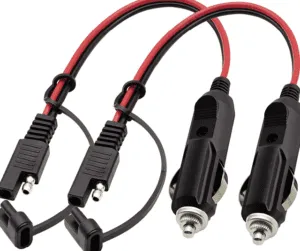
We like the broad deck mounting flange. We like the molded seal. Between these two factors, they absolutely cannot leak through the deck. Most have tinned wire, and because they are used for motorbike charging, the wire is typically at least 14 AWG.
Maintain polarity. If you are careful with your wiring you’ll ensure correct polarity.
We have used these SAE connectors on a Stilleto 27 for 8-10 years with no problems, while multiple brands of “marine-grade” connectors failed.
The COLREGs allows two lighting schemes for sailboats; either red and green side lights plus a stern light, or a single tricolor mounted at the top of the mast. The advantage of the tricolor is that it can be seen above waves. However, like a masthead anchor light, it is hard to see at close range. Also you can’t use a tricolor when motoring, since your white steaming light indicating a power-driven vessel must be above the side lights.
A less commonly seen combination is for sailing boats is red over green, one meter apart, at or near the top of the mast. This is in addition to the usual side lights farther down and the white stern light. Advantages of this setup are increased visibility in waves, visibility in close quarters, and unlike the other options, a means of estimating distance, since more than one light is visible at a time.
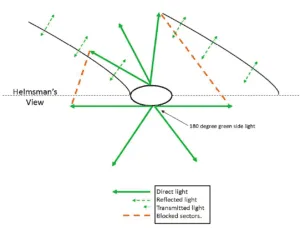
It is widely believed that the red-over-green light is for sailboats longer than 20 meters, but in fact there is no size restriction. A tricolor cannot be used by boats over 20 meters, and so red-over–green makes sense for them at sea. Ideally, the lights are above the mast and unobstructed in all directions. A one meter mast light could also be attached to the top of the mast; it won’t increase the air draft by one meter, since the VHF aerial is probably more than half that.
However, the USCG COLREGS manual clearly shows the green light some distance down the mast, where it will be blocked in some directions by the mast and sails. Green light will also reflect off the sails, which can be annoying. Commonly, instead of a single green light, 180-degree green side lights are mounted on each side of the mast, 1-meter down, with a red light at the masthead.
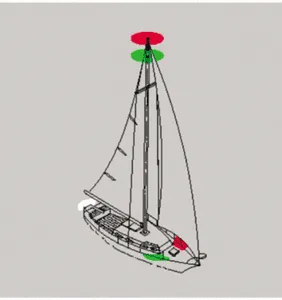
This requires one more pair of lights, but no more cabling than a tricolor. However, a hoistable red-over-green modular light like the one described in the adjacent articles could be used when more visibility is desired.
A paper recently submitted to World Sailing lays out the problems sailboats face trying to comply with the COLREGs ( http://honeynav.com/wp-content/uploads/2020/04/OC4biNavigationLightReportVerFinal-25596.pdf ).
RELATED ARTICLES MORE FROM AUTHOR
What your boat and the baltimore super container ship may have in common.
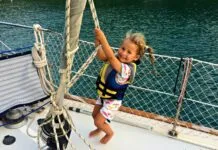
How Can I Keep My Kids Safe Onboard?
Sailboats under no circumstance are under the category of ram. They are not restricted of maneuver. No need for this
Where did you get this idea? Sailing vessels had in the past performed many of the tasks in Colregs Rule 3(g) and most are also auxillary power driven vessels. They can, for instance, engage in emergency towing and are then very much in a RAM condition. Bering Sea Gold had a sailboat involved in dredging (and diving!). The same lights are used for diving. People don’t dive off sailboats? That’s news. Sailboats can be aground, and then should display two red all around lights. Just omit the white in between.
Which case do you disagree with and why? Diving at night (COLREGS rule 27ei and state law)? Lying to a drogue (steering is greatly restricted and in survival conditions releasing the drogue is not an option)?
Sail or power is not a factor in these determinations. Very likely the sailboat has no sail up and is a power driven boat for the purposes of COLREGS.
LEAVE A REPLY Cancel reply
Log in to leave a comment
Latest Videos
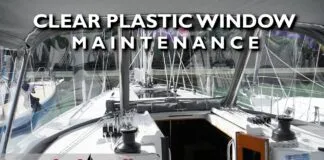
What’s The Best Vinyl Window Cleaner for Your Boat?

40-Footer Boat Tours – With Some Big Surprises! | Boat Tour

Electrical Do’s and Don’ts

Bahamas Travel Advisory: Cause for Concern?
- Privacy Policy
- Do Not Sell My Personal Information
- Online Account Activation
- Privacy Manager

Best LED Navigation Lights

Last Updated by
Daniel Wade
May 3, 2023
Key Takeaways
- Navigation lights offer safety to you and other boaters
- You must understand how boat navigation lights rules are important
- Bow light and stern light are red and green respectively
- Pontoon boat navigation lights are similar to other marine navigation lights and their use
- The best boat navigation lights will vary based on a variety of factors to you
Boating at night requires proper lighting in order to ensure safe travels. So what are some of the best LED navigation lights?
Brands such as Shangyuan, Linkstyle, Partsam, and Obcursco make high quality LED boat navigation lights. Each brand will have a variety of factors that make them the best LED boat navigation lights such as price, quality of materials, and a super bright light.
In my years of experience some brands are definitely better than others. Price appears to be a driving factor but keep in mind what the boat lights intended use is for and how it applies to your situation.
Table of contents
The Top 12 Best LED Boat Navigation Lights
Using LED boat lights is a smart choice for those who frequently sail or engage in open water activities. These are especially needed to obtain sufficient lighting for both the interior and exterior of their boat during night or dawn trips.
Partsam LED Lights

The Partsam round chrome light is a waterproof LED boat navigation light that doubles as an interior boat cabin light. It is made from top chrome bezel and high-grade plastic that make it durable and lightweight.
It comes with mounting screws and is easy to install with its flush mount. It is also compatible with 12 volt DC power.
- Waterproof and durable against all elements
- Can be used in both interior or exterior of your boat
- Installation is easy and it is super bright
- Not meant to be submerged especially in salt water
- Cannot dim the lights
Shangyuan Boat Navigation Lights LED Strip

The Shangyuan LED boat running lights are versatile and reliable for use all over the boat. These are especially used for:
- Stern lights
- Starboard and port sides
These LED boat navigation lights are ideal for small boats, kayaks, pontoons, and sailboats. The 3.8-inch LED strips are green for the starboard side and red for the port side. They meet maritime requirements and are battery-powered.
These running lights can withstand harsh marine conditions and provide exceptional brightness and performance. The slim ABS casing needs careful screw tightening to avoid cracking. They are easy to install and durable even in harsh environments during hunting and winter seasons.
- Be seen on the water with proper navigation lights
- Energy efficient
- Overtightening the screw can damage light casing
- Meant for small boats
Obcursco LED Navigation Lights Kit
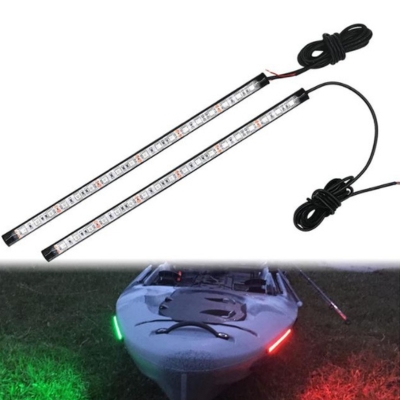
Obcursco makes a great boat navigation light kit. This LED navigation light is perfect for low light settings and rough weather with a 12v DC power and IP67 waterproof rating.
It is corrosion-resistant and impact-proof thanks to the ABS material while tightly sealed LEDs ensure full waterproofing. With easy installation using 3M adhesive it is a versatile option for boats and land use alike.
- Easy to adjust lights
- Waterproof and has durable materials
- Easy to install
- Might need to glue the lights in addition to the 3M tape
- Does not include instructions
Linkstyle Marine Boat Navigation Lights

Linkstyle's marine LED boat navigation lights are a durable and versatile option for various boat types. Its corrosion-resistant design features waterproof red and green LED units, an ABS plastic casing with a stainless steel enclosure, and polycarbonate-lenses lamps.
The lightweight and easy-to-install design is ideal for hunting and fishing. The 225-degree mounting angle ensures maximum luminance and safety compliance. These IP65 waterproof safety lamps use 16 LED bulbs powered by a 12V battery to widen visibility during reduced visibility conditions.
- Lightweight and durable to outdoor marine conditions
- Easy installation
- Ideal for smaller boats
- Installing wrong may cause navigation issues
- Not meant for larger boats
OPT7 Aura PRO LED Kit

The OPT7 Marine LED Kit is for hassle-free and waterproof boat lighting. It features SoundSync bass-activated technology, a handheld remote, and one-touch color selection with advanced dimming options.
The kit contains four LED strips, connectors, extension wires, power harness, mounting kit, and other accessories. This beats looking for everything individually but the price point might deter some buyers wanting a simple setup.
- Super bright lighting
- Easy to install and plug into 12 volt power
- Comes with remote and various light features
- Remote is not the best quality
- Might be overpriced for those wanting a simpler LED kit
Interwebz Boat Bow Navigation

Interwebz has waterproof LED bow navigation lights in red and green for boats that can be connected to a 12-volt battery or a standard pole. Proper labeling is required for night trips.
It has stylish mounting options for the boat's rub rail with a black cover that blends in with the exterior surfaces. Suitable for various boats such as bass, ski, and fishing boats, the lights are weatherproof with an IP68 rated silicone casing.
- Easily seen lighting
- Has six foot cord to connect anywhere on the boat
- Great weatherproof rating
- Likely have to use marine grade silicone to keep it secure
PryEU Daylight White

The PryEU Daylight White 6000K is an energy-efficient and versatile waterproof lighting fixture that uses 3M double-sided foam tape for secure attachment. It has a 12v DC voltage compatibility and consumes only 1.5 watts and makes it ideal for marine interiors and other spaces.
Installation is easy but it involves surface cleaning and sticking it to the adhesive backing. A three year warranty plus 60 days replacement and fast delivery with customer support are provided by the manufacturer.
- Excellent energy efficiency
- Solid waterproof rating
- Easy to install and has three year warranty
- Might need silicone to help make it stay
- Lights cannot be dimmed
Amzonly LED Navigation Lights
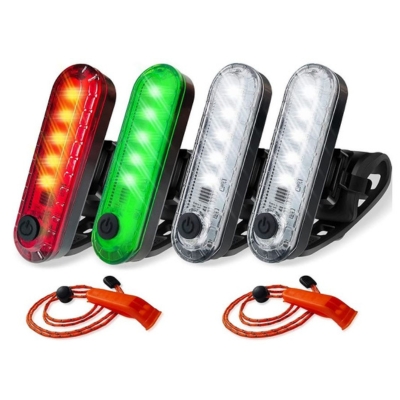
AMZONLY LED boat navigation lights are a versatile and top-rated kit with red and green LEDs for the bow and port side and white for the stern. They have three flashing modes and a magnetized screwdriver for easy battery changes.
This IPX5 weather-resistant light kit comes with four LEDs, 12 3-volt batteries, three elastic straps, one long armband, and a 12-month return policy. This is suitable for kayaks, yachts, motorboats, and pontoons and they can be used as a flush mount navigation light, masthead light, taillight, running light, or flashing light.
- Easy to install kit with everything you need
- One year return policy
- Solid waterproof and weatherproof capabilities
- Not intended to be submerged or soaked
Leaningtech LED Boat Navigation Lights

The LEANINGTECH Marine LED is a waterproof and adaptable lighting choice for boats that is known for its brightness, energy efficiency, and USCG compliance. Its durable construction from ABS plastic and chrome plaid zinc ensures both lightweight and waterproof properties with an IP65 rating.
It can serve various purposes that as a source of lighting for different types of boats. It can also serve as a bow, running, or stern light.
- Great brightness
- Easy to install and is made from quality materials
- Has multiple functions for use
- Gauge for wires is a bit small
- Some reports say it did not hold up well in salt water conditions
Osinmax Boat Navigation Light
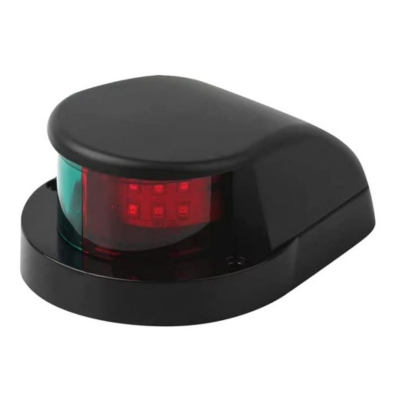
The Osinmax LED boat navigation lights is a top-rated energy-saving set that uses a 3W LED bulb and 12V DC power. With green and red lenses it offers masthead-like running lights that ensure you will be seen up to two miles.
The housing is waterproof with an IP67 high-density seal ring made of foam silicone rubber that helps prevent short circuits from splashes. The lights comply with maritime navigation, wildlife, and fisheries regulations, and install easily with one screw.
- Low power consumption and is super bright
- Designed to keep water out
- Can be used as courtesy lights
- Might need to add silicone to adhere the back side
- Might be difficult to install on some boats
Lumitec SeaBlazeX Boat Navigation Lights

To attain premium illumination you should opt for the Lumitec SeaBlazeX LED with 12-24V DC power that emits 4,000 lumens. Its marine-grade bronze housing enables convenient flat surface installation.
It offers versatile programmable features such as cross-fade and strobe. Perfect for subaquatic use, preventing discoloration, it is available in blue, green, white, and white/blue hues.
- Durable in salt water conditions
- Solid underwater submersion capabilities
- Bright lights in various colors
- Cannot dim lights
- Somewhat expensive compared to similar brands
Five Oceans Boat Navigation Lights

Boaters prefer Five Oceans' marine LED boat navigation lights for clear visibility up to two miles. These dual-function green and red lights serve as stern, flushing, and bow lights.
They are made of lightweight ABS plastic and alloy covers.They are also brighter and longer-lasting compared to other boat navigation lights.
These low-tension safety lights connect to a 12V power source for energy efficiency and superior visibility. With a UV-resistant feature and a lifespan of about 50,000 hours they are top choice. No additional sealing is required thanks to their rubber seal.
- IP66 protection and endure splashes
- Easily install the 3W bi-color LEDs at a 225-degree angle using the included screws
- Bright boat navigation lights that can be seen two miles away
- Does not look as appealing as other boat navigation lights
What to Expect from LED Boat Navigation Lights
To simplify your selection process when looking for LED lighting fixtures to accessorize, you will need to research a variety of factors based on your needs. If you wish to upgrade or replace your boat navigation lights here are some key factors to consider.
Lighting Capability
LED lights have evolved to meet diverse lighting needs with some producing clear white light and others providing brightness from any direction. Lumens is the term used to describe the amount of light generated by a particular brand of LED lights.
Angle of the Lights
To avoid eye damage it is crucial to factor in the beam angle when purchasing LED boat lights. Read reviews from past customers to gauge the intensity of the light directed at you or from an angle. Strong LED lighting fixtures can harm your eyes so be cautious.
Energy Efficiency
Comparing the percentage of energy needed to produce sufficient light is crucial when selecting lighting fixtures such as LED lights. Higher lumens per watt make LED lights more cost-effective in terms of energy consumption.
Red Light Output
Excessive heat generation in boat LED lights is a significant concern for buyers. To ensure optimal lighting quality it is crucial to consider the heat output of the chosen LED light.
Ease of Installation
Multiple installation techniques for navigation lights cater to different boating needs but mount components should be ensured for both wired and battery-operated choices. Mounting options range from screws to armbands.
Wired lights are recommended for safety while small boats can benefit from the versatility of battery-operated LED lights. The chosen installation method impacts functionality, service life, and safety, ultimately safeguarding lives and property.
LED light prices will vary depending on select features such as materials used and the manufacturer's design availability. Choosing a manufacturer depends on the buyer's budget and preferences for the intended use of the boating adventure.
Customized features and extended warranty may result in higher prices. To obtain the finest LED light bargain you should scrutinize LED boat lighting warranties that typically span from one to seven years. Do not settle for one that is the cheapest option since it might not suit your intended use or last as long as you may hope.
Quality Materials
To ensure the longevity of LED lights it is crucial for prospective buyers to consider the material used. If the material is prone to rust then the light will eventually corrode.
Always check the manufacturer's material-composition and avoid products made primarily of alloy coating. You should for opt for a top-grade metal or alloy material from a reputable LED light brand.
Your lighting source must be tightly sealed and capable of withstanding harsh weather and moisture. When using LED lights for marine and saltwater expeditions, verify the IP rating.
Look for an IP67 rated LED product. This means it confirms its ability to endure any weather conditions and even some underwater submersion.
Why You Need LED Boat Navigation Lights
LED navigation lights offer numerous benefits. They primarily are designed to allow safe transport on the waterways so that other boats can see you.
Choose quality LED lights for greater energy efficiency and significant cost savings compared to incandescent bulbs. LED lights have diverse uses on land and sea, being useful for lighting homes, businesses, and buildings.
Marine LED cabin lights have become popular as decorative lighting inside homes, while others use LEDs for entertainment, transportation, spotlighting, or reading. LEDs are considered essential lighting tools in any setting.
Other reasons to have efficient ones include:
- Easy installation and durable marine-grade construction
- Versatile performance options based on different brands
- Improved visibility for boat status and navigation
- Helps prevent accidents caused by extreme weather and reduced visibility
- Retain compliance with wildlife and marine laws
- Multiple usage options in other marine applications
Differences in LED Boat Navigation Lights
The boat light packaging is compact upon delivery and LED lights operate similarly to incandescent bulbs. They are initially designed for lighting boats but a lot of these lights now serve multiple purposes and come in various types.
- Navigation: Are essential for indicating the position and direction of sea vessels. Usually with red and green lights in addition to white.
- Anchor: The anchor light serves to locate and signal the presence of a docked vessel
- White: Provides adequate lighting all around the boat
- Deck: These lights offer lighting in areas that you walk through often
- Dock: Serve as bright illumination for boaters or mariners during departure or arrival at a marina
- Underwater: These are submerged or placed near water to lure sea creatures during nighttime fishing expeditions.
- Search: Search lights are essential for boat users to locate objects on deck or in water.
Which Colors Do You Need for Your Boat?
Boat navigation lights consist of red sidelight for port side and green sidelight for starboard side. White lights serve as anchor, masthead, or stern lights.
If you cannot remember how to tell the two apart you can always think of port red wine. There is a saying that you can easily remember such as “there is no red port wine left”. This way you do not have to worry about the starboard side since it works itself out in the phrase if you can remember the port side.
Navigation lights are unnecessary for illumination during normal boat motion except in low visibility conditions. If you decide to use other lights on your boat make sure that they are not in use during lower light conditions so that other boaters are not confused by your setup.
Related Articles
I've personally had thousands of questions about sailing and sailboats over the years. As I learn and experience sailing, and the community, I share the answers that work and make sense to me, here on Life of Sailing.
by this author
Most Recent
Important Legal Info
Lifeofsailing.com is a participant in the Amazon Services LLC Associates Program, an affiliate advertising program designed to provide a means for sites to earn advertising fees by advertising and linking to Amazon. This site also participates in other affiliate programs and is compensated for referring traffic and business to these companies.
Similar Posts
Popular posts.

Best Liveaboard Catamaran Sailboats
December 28, 2023

Can a Novice Sail Around the World?
Elizabeth O'Malley
June 15, 2022

4 Best Electric Outboard Motors

How Long Did It Take The Vikings To Sail To England?

10 Best Sailboat Brands (And Why)
December 20, 2023

7 Best Places To Liveaboard A Sailboat
Get the best sailing content.
Top Rated Posts
Lifeofsailing.com is a participant in the Amazon Services LLC Associates Program, an affiliate advertising program designed to provide a means for sites to earn advertising fees by advertising and linking to Amazon. This site also participates in other affiliate programs and is compensated for referring traffic and business to these companies. (866) 342-SAIL
© 2024 Life of Sailing Email: [email protected] Address: 11816 Inwood Rd #3024 Dallas, TX 75244 Disclaimer Privacy Policy
- International
March 26, 2024 - Baltimore Key Bridge collapses after ship collision
By Helen Regan , Kathleen Magramo , Antoinette Radford, Alisha Ebrahimji , Maureen Chowdhury , Rachel Ramirez , Elise Hammond , Aditi Sangal , Tori B. Powell , Piper Hudspeth Blackburn and Kathleen Magramo , CNN
Ship lights flickered and veered off course shortly before Baltimore bridge hit, CNN analysis shows
From CNN’s Allegra Goodwin in London
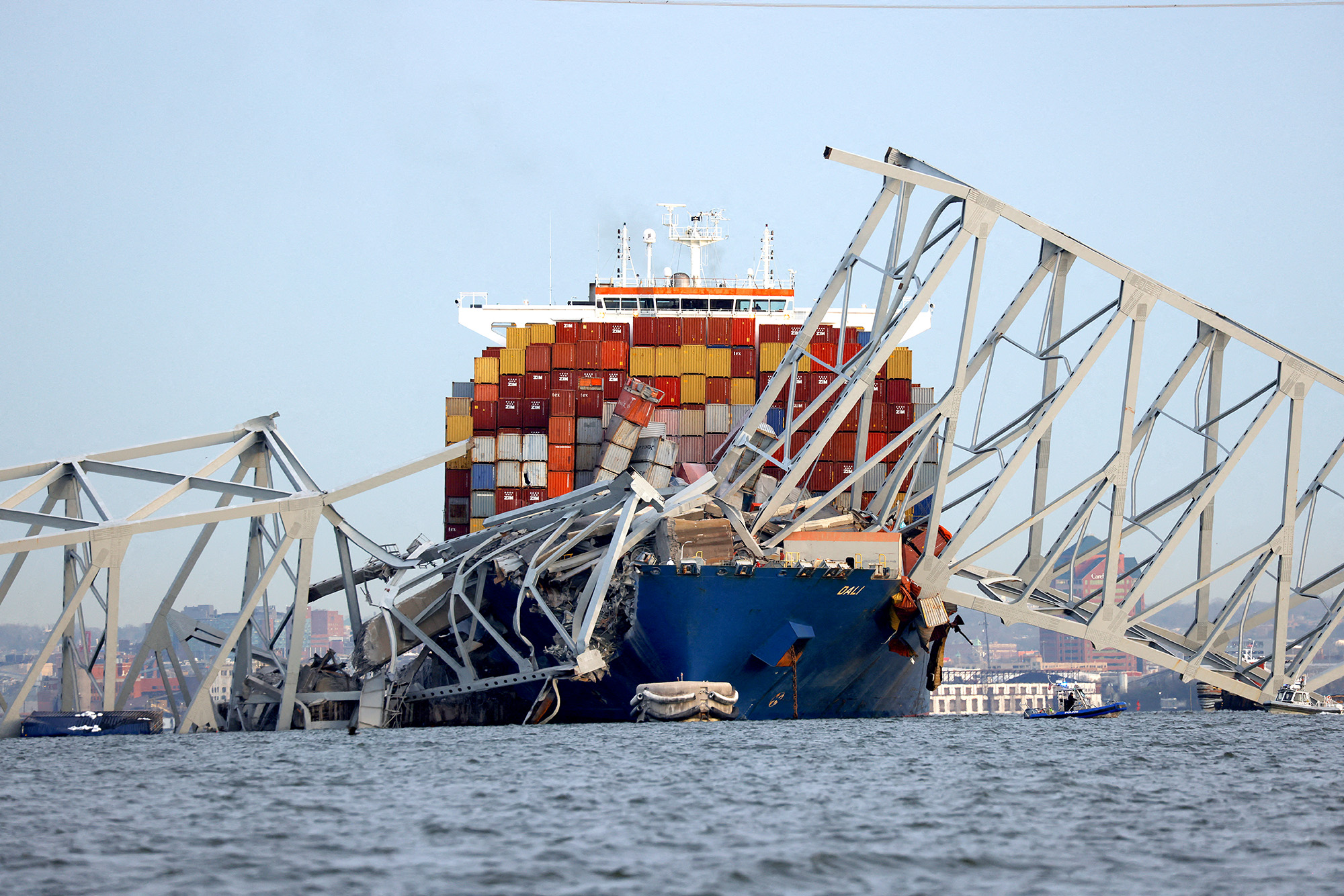
The Singaporean-flagged cargo ship that struck the Francis Scott Key Bridge in Baltimore Tuesday altered course and veered toward a pillar shortly before impact, a CNN analysis of MarineTraffic ship-tracking data confirms.
It’s unclear what caused the ship to crash into the bridge or why its lights were flickering. CNN has reached out to the National Transportation Safety Board to inquire about a possible power failure.
The container ship DALI, which was en route to Colombo, Sri Lanka, begins to change course toward the bridge’s pillar at 1:26 a.m. local time, striking the bridge at 1:28 a.m. ET, according to MarineTraffic data and video from the scene. Video from 1:25 a.m. ET shows a plume of dark smoke billowing from the ship. DALI's lights flicker at least twice before the incident.
In video, as it navigates down the Patapsco River, the ship’s lights can be seen going out at 1:24 a.m. ET, before turning back on, and then flickering off and on again between 1:26 a.m. ET and 1.27 a.m. ET, just before it hits the bridge.
Maryland transportation secretary says contractors were working on bridge at time of collapse
From CNN's Antoinette Radford
Maryland State Transportation Secretary Paul Wiedefeld told reporters there were workers on the Francis Scott Key Bridge at the time of its collapse.
"We know there were individuals on the bridge at the time of the collapse, working on the bridge, contractors for us," he said at a news conference Tuesday morning.
Wiedefeld said the workers were "basically doing some concrete deck repair," but said they did not know how many vehicles were involved.
He added that the transport authority has set up a facility for family members of those who were believed to be on the bridge at the time of its collapse.
Baltimore fire chief: Sonar has detected the presence of vehicles submerged in the water
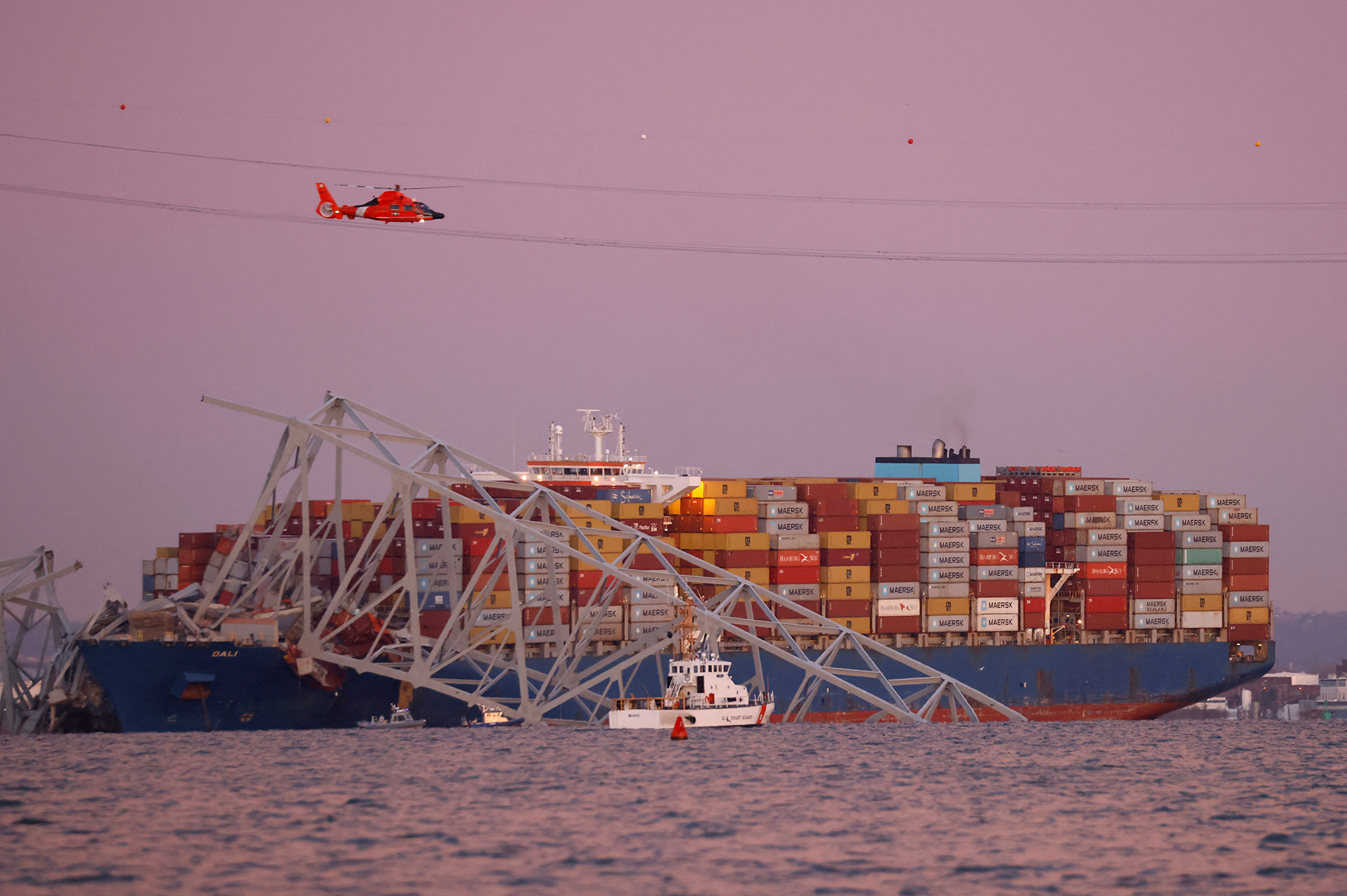
Baltimore Fire Chief James Wallace says authorities have detected vehicles submerged in the water.
“Our sonar has detected the presence of vehicles submerged in the water,” said Wallace at a news conference on the collapse of Francis Scott Key Bridge. “I don't have a count of that yet.”
He said emergency services are using sonar, drones and infrared technology as a part of their search for people and vehicles who may have fallen from the Key Bridge into the Patapsco River.
No indication of "terrorism" or intent in Baltimore bridge collapse, police chief says
From CNN’s Andy Rose
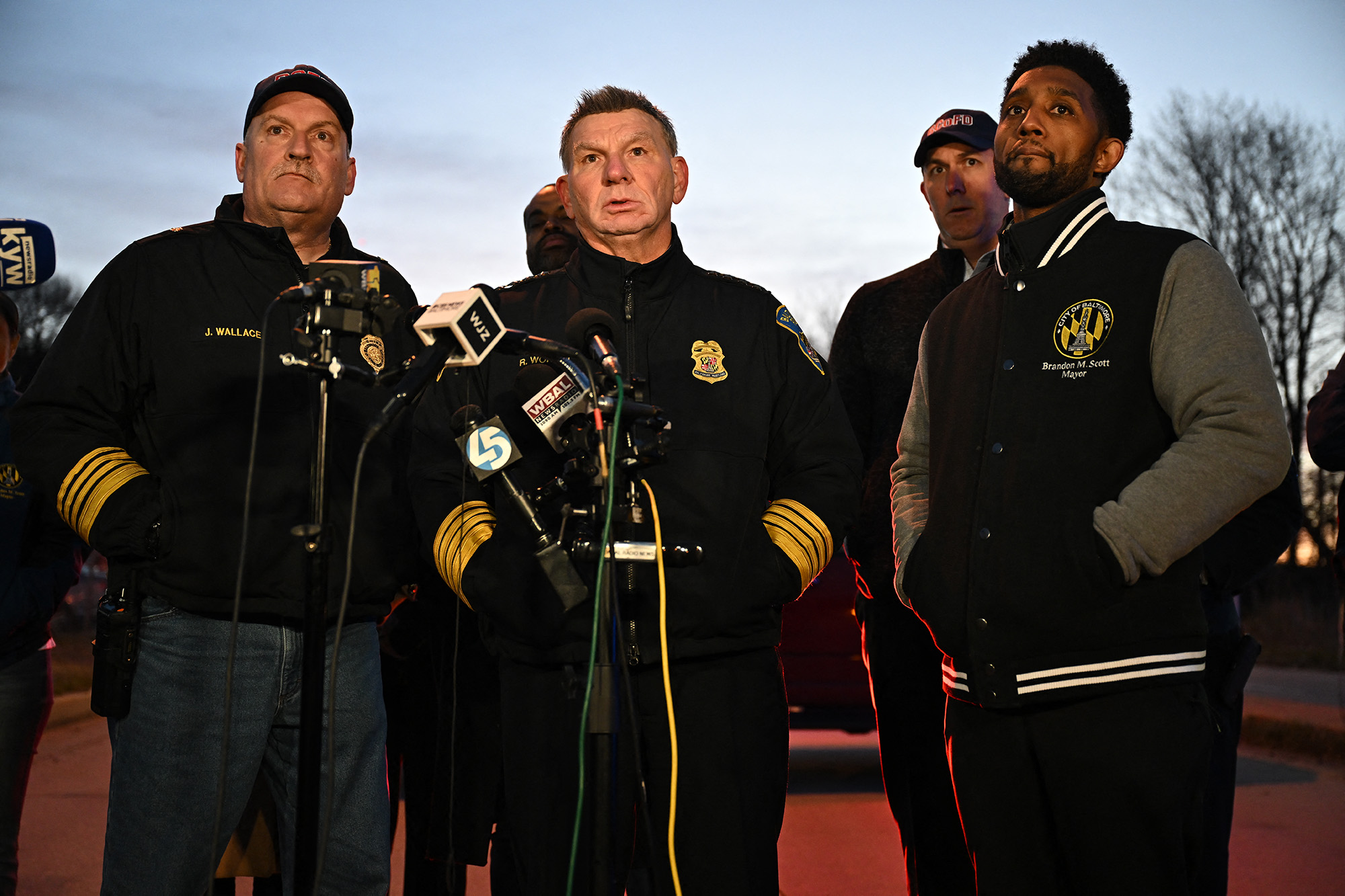
Baltimore Police said there was no evidence that the ship collision that caused the collapse of the Francis Scott Key Bridge was intentional.
“There is absolutely no indication that there's any terrorism, that this was done on purpose,” Chief Richard Worley said at a news conference.
The FBI said that it was joining the investigation into the cause of the collision.
Rescue crews have determined there are vehicles in the Patapsco River following the bridge collapse.
“Our sonar has detected the presence of vehicles submerged in the water,” said Fire Chief James Wallace. “I don't have a count of that yet.”
Wallace said they are waiting to make sure that the ship is secure and stable before investigators board it.
“Never would you think that you would see, physically see, the Key Bridge tumble down like that,” Mayor Brandon M. Scott said.
Cruises, cars and commodities: What to know about the Port of Baltimore
From CNN's Mark Thompson and Hanna Ziady

The collapse of the Francis Scott Key Bridge over the Patapsco River outside the Port of Baltimore threatens to disrupt shipping operations at a major US trade hub for autos, container traffic and commodities. Baltimore also has a cruise terminal.
Closer to the Midwest than any other port on the East Coast, Baltimore ranks first in the United States for autos and light trucks, handling a record 850,000 vehicles last year. It was also the leading port for farming and construction machinery, as well as imported sugar and gypsum. It was second in the country for exporting coal.
Overall, Baltimore ranks as the 9th biggest US port for international cargo, handling a record 52.3 million tons, valued at $80.8 billion in 2023.
“The immediate focus is the rescue operation, but there will clearly be a highly-complex recovery phase and investigation to follow and we don't know what impact this will have on operations at the Port of Baltimore," said Emily Stausbøll, market analyst at Norway-based shipping analytics company Xeneta.
“While Baltimore is not one of the largest US East Coast ports, it still imports and exports more than one million containers each year so there is the potential for this to cause significant disruption to supply chains," she added.
Baltimore's cruise terminal serves ships operated by Royal Caribbean, Carnival and Norwegian. Cruises carrying more than 444,000 passengers departed from the port last year.
According to the Maryland state government, the port supports 15,330 direct jobs and 139,180 jobs in related services.
Rescue crews looking for at least seven people in Baltimore bridge collapse
Rescue operations are underway near the wreckage of the Francis Scott Key Bridge in Baltimore, as crews look for people who fell into the Patapsco River.
“We are still very much in an active search and rescue posture at this point, and we will continue to be for some time,” Wallace added.
Baltimore Fire says two people have been rescued from the river – one who was uninjured, and another in hospitalized “very serious condition.”
“This is an unthinkable tragedy,” Mayor Brandon Scott said. “We have to first and foremost pray for all of those impacted.”
Ship that collided with Baltimore bridge was chartered by Danish shipping company Maersk
From CNN's Alex Stambaugh in Hong Kong

The container ship that collided with the Francis Scott Key Bridge in Baltimore on Tuesday was chartered by Maersk and carrying their customers' cargo, the Danish shipping company told CNN.
"We are horrified by what has happened in Baltimore, and our thoughts are with all of those affected," The company said in its statement.
The company, which has a full name of A.P. Moller - Maersk, said no company crew and personnel were onboard the vessel. It said the ship, DALI, is operated by charter vessel company Synergy Group.
"We are closely following the investigations conducted by authorities and Synergy, and we will do our utmost to keep our customers informed," the statement said.
CNN is attempting to contact the owner and managers of the ship, including Synergy.
FBI Baltimore on the scene at the Key Bridge
FBI Baltimore personnel are on the scene at the Francis Scott Key Bridge, they have said in a post on X.
The agency said it was working "side by side with our local, state and federal partners."
Baltimore fire emergency chief says 2 people saved from water after Key Bridge collapse
The Baltimore Fire Department Chief James Wallace says authorities rescued two people from the water this morning, one without injury and the other who has been transferred to hospital in a serious condition.
Authorities are continuing their search for upwards of seven people, Wallace says. But, he says that number could change as it is a "very large incident." Earlier on Tuesday, an official said as many as 20 people could be in the water.
Wallace added that the crew remains on board the ship, and are communicating with the US Coast Guard. He added that emergency services are looking into reports that there were workers on the bridge at the time of the incident.
Speaking at the press conference, Baltimore Mayor Brandon Scott also described the incident as an “unthinkable tragedy,” and offered his prayers for all those affected, as well as his thanks to first responders.
Please enable JavaScript for a better experience.
- Grand Rapids/Muskegon
- Saginaw/Bay City
- All Michigan
Portion of St. Marys River remains closed after big freighter hits buoy, no pollution reported
- Published: Mar. 28, 2024, 1:36 p.m.

U.S. Coast Guard Air Station Traverse City responds to the American Mariner marine casualty in Munuscong Lake, Michigan, March 28, 2024. (Photo provided by U.S. Coast Guard) Photo provided by U.S. Coast Guard
- Matt Durr | [email protected]
SAULT STE. MARIE, MI -- The U.S. Coast Guard says a portion of the St. Marys River will remained closed until a big freighter can be safely removed from the river after it hit a buoy Thursday morning. The river - which upbound and downbound ships use as they head to and from the Soo Locks - is closed from Nine Mile Point to Point Aux Frenes for the time being.
Related story: Coast Guard closes part of St. Marys River following ‘marine casualty’ to commercial vessel
No injuries or pollution are being reported as a result of the crash, the Coast Guard said. The ship is now anchored in the river until it can be moved. The American Mariner, a 730-foot bulk cargo ship, was not carrying any cargo when it hit the Mud Lake Junction Light with its bow around 1 a.m. Coast Guard crews responded to the scene on Munuscong Lake shortly after the crash.
The freighter had left its Wisconsin port on Lake Michigan yesterday for its first trip of the shipping season.
Stories by Matt Durr
- Internet access for millions could be lost as funding is running out for discount program
- Fight over parking spot at blues bar leads to 5 people being shot
- Coast Guard suspends search for missing person in St. Clair River
If you purchase a product or register for an account through a link on our site, we may receive compensation. By using this site, you consent to our User Agreement and agree that your clicks, interactions, and personal information may be collected, recorded, and/or stored by us and social media and other third-party partners in accordance with our Privacy Policy.

Wife of Baltimore bridge collapse survivor says workers were on break in their cars when bridge came down
B ALTIMORE — The wife of one of the construction workers who survived the Francis Scott Key Bridge collapse says it’s a miracle he is alive as he doesn’t know how to swim.
Julio Cervantes was one of eight construction workers on the bridge when the Dali cargo ship’s lights flickered on and off and crashed into a support pillar, sending the bridge into the Patapsco River in the early hours of Tuesday morning.
He and another man were rescued Tuesday. The bodies of two more were recovered Wednesday. The remaining four have not been found but are presumed dead.
“All of the men were on a break in their cars when the boat hit. We don't know if they were warned before the impact,” Cervantes' wife, who did not disclose her name, told NBC News on Thursday.
Mere seconds after the Dali hit the bridge, it appeared to snap and fall into the dark water below.
“My husband doesn’t know how to swim. It is a miracle he survived,” the wife said.
Cervantes was taken to the hospital with a chest wound and was released the same day, his wife said. The other worker rescued Tuesday was in good condition and refused treatment, authorities previously said.
The remains of Alejandro Hernandez Fuentes, 35, and Dorlian Ronial Castillo Cabrera, 26, were recovered by searchers in the Port of Baltimore Wednesday morning, found in a red pickup truck trapped in 25 feet of water near what was once the middle of the bridge.
Hernandez Fuentes , 35, was from Mexico and lived in Baltimore, Castillo Cabrera, 26, was from Guatemala and lived in Dundalk, Maryland.
Cervantes' wife said that her brother-in-law was one of the two men recovered yesterday, but did not share his name. She said her entire family is of Mexican origin, and her nephew is still among the missing.
“We haven’t been able to sleep, waiting for word if they’re going to find a relative,” she said.
The recovery effort is now a salvage operation with the four workers presumed dead still missing.
Audio from dispatch radio, published by Broadcastify, captured the moment police officers rushed to stop traffic and close the bridge — a move that likely saved countless lives — and called for a warning to the crew working on the bridge.
An officer on the dispatch audio said, “I’m not sure where, there’s a crew up there you might want to notify, whoever the foreman is, see if we can get them off the bridge temporarily.”
Another officer replied saying that once another police unit arrives, “I’ll go grab the workers on the Key Bridge.”
But it was too late. Moments later another officer said over the radio: “The whole bridge just fell down! Start, start ... everybody. The whole thing just collapsed.”
The collapse sent shockwaves across the country, sparked supply chain concerns and broke the hearts of locals who considered the Francis Scott Key Bridge, which stretches a mile and a half and carries Interstate 695, a jewel in the city. President Joe Biden has vowed to reconstruct the bridge as soon as possible.
An investigation into what caused the crash and subsequent bridge collapse is underway by the National Transportation Safety Board. It is anticipated to take one to two years .
George Solis reported from Baltimore and Marlene Lenthang from Los Angeles.
This article was originally published on NBCNews.com
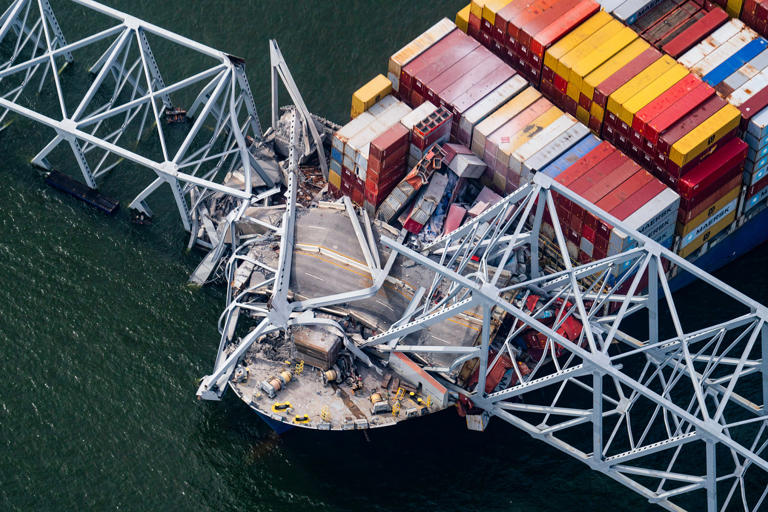
Six presumed dead after cargo ship crash levels Baltimore bridge
BALTIMORE — A major Baltimore bridge collapsed like a house of cards early Tuesday after it was struck by a container ship, sending six people to their deaths in the dark waters below, and closing one of the country’s busiest ports.
By nightfall, the desperate search for six people who were working on the bridge and vanished when it fell apart had become a grim search for bodies.
“We do not believe that we’re going to find any of these individuals still alive,” Coast Guard Rear Admiral Shannon N. Gilreath said.
Jeffrey Pritzker, executive vice president of Brawner Builders, said earlier that one of his workers had survived. He did not release their names.
Up until then, Maryland Gov. Wes Moore had held out hope that the missing people might be found even as law enforcement warned that the frigid water and the fact that there had been no sign of them since 1:30 a.m. when the ship struck Francis Scott Key Bridge.
Moore expressed heartbreak after officials suspended the search for survivors.
"Our heart goes out to the families," he said. "I can’t imagine how painful today has been for these families, how painful these hours have been have been for these families."
It was a crushing blow to the loved ones of the missing men, who had waited for hours at a Royal Farms convenience store near the entrance of the bridge for word of their fate.
Follow live updates on the Baltimore bridge collapse
The tragic chain of events began early Tuesday when the cargo ship Dali notified authorities that it had lost power and issued a mayday moments before the 984-foot vessel slammed into a bridge support at a speed of 8 knots, which is about 9 mph.
Moore declared a state of emergency while rescue crews using sonar detected at least five vehicles in the frigid 50-foot-deep water: three passenger cars, a cement truck and another vehicle of some kind. Authorities do not believe anyone was inside the vehicles.
Investigators quickly concluded that it was an accident and not an act of terrorism.
Ship was involved in another collision
Earlier, two people were rescued from the water, Baltimore Fire Chief James Wallace said. One was in good condition and refused treatment, he said. The other was seriously injured and was being treated in a trauma center.
Moore said other drivers might have been in the water had it not been for those who, upon hearing the mayday, blocked off the bridge and kept other vehicles from crossing.
“These people are heroes,” Moore said. “They saved lives.”
Nearly eight years ago, the Dali was involved in an accident. In July 2016, it struck a quay at the Port of Antwerp-Bruges in Belgium, damaging the quay.
The nautical commission investigated the accident, but the details of the inquiry were not immediately clear Tuesday.
The Dali is operated and managed by Synergy Group. In a statement, the company said that two port pilots were at the helm during Tuesday's crash and that all 22 crew members onboard were accounted for.
The Dali was chartered by the Danish shipping giant Maersk, which said it would have no choice but to send its ships to other nearby ports with the Port of Baltimore closed.
The bridge, which is about a mile and a half long and carries Interstate 695 over the Patapsco River southeast of Baltimore, was "fully up to code," Moore said.
National Transportation Safety Board Chairwoman Jennifer Homendy said that her agency will lead the investigation and that a data recorder on the ship could provide more information.
"But right now we're focusing on the people, on the families," she said. "The rest can wait."
President Joe Biden vowed to rebuild the bridge and send federal funds.
"This is going to take some time," the president warned. "The people of Baltimore can count on us though to stick with them, at every step of the way, till the port is reopened and the bridge is rebuilt."
Speaking in Baltimore, Transportation Secretary Pete Buttigieg echoed the president's promise.
"This is no ordinary bridge," he said. "This is one of the cathedrals of American infrastructure."
But Buttigieg warned that replacing the bridge and reopening the port will take time and money and that it could affect supply chains.
The Port of Baltimore, the 11th largest in the U.S., is the busiest port for car imports and exports, handling more than 750,000 vehicles in 2023 alone, according to data from the Maryland Port Administration.
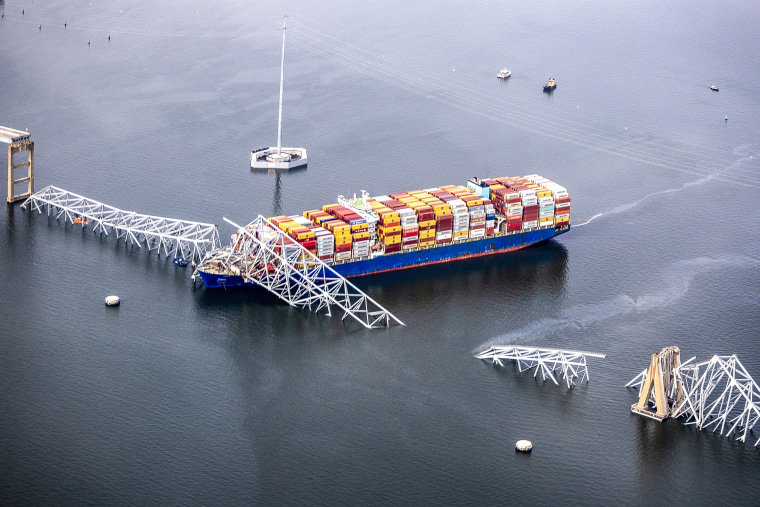
Writer David Simon, a champion of Baltimore who set his TV crime drama "The Wire" on the streets of the city he once covered as a reporter, warned online that the people who will suffer the most are those whose livelihoods depend on the port.
"Thinking first of the people on the bridge," Simon posted on X . "But the mind wanders to a port city strangling. All the people who rely on ships in and out."
Timeline of crash
Dramatic video captured the moment at 1:28 a.m. Tuesday when the Dali struck a support and sent the bridge tumbling into the water. A livestream showed cars and trucks on the bridge just before the strike. The ship did not sink, and its lights remained on.
Investigators said in a timeline that the Dali's lights suddenly shut off four minutes earlier before they came back on and that then, at 1:25 a.m. dark black smoke began billowing from the ship's chimney.
A minute later, at 1:26 a.m., the ship appeared to turn. And in the minutes before it slammed into the support, the lights flickered again.
Maryland Transportation Secretary Paul Wiedefeld said the workers on the bridge were repairing concrete ducts when the ship crashed into the structure.
At least seven workers were pouring concrete to fix potholes on the roadway on the bridge directly above where the ship hit, said James Krutzfeldt, a foreman.
Earlier, the Coast Guard said it had received a report that a “motor vessel made impact with the bridge” and confirmed it was the Dali, a containership sailing under a Singaporean flag that was heading for Sri Lanka.
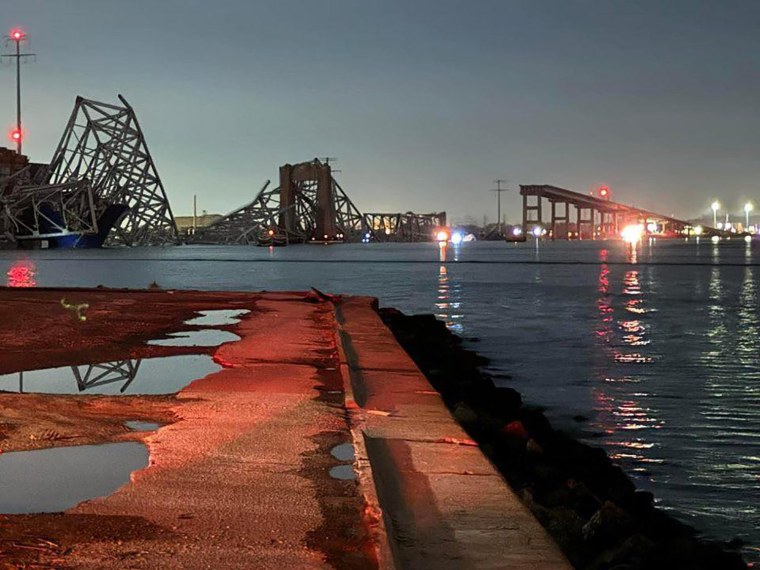
Bobby Haines, who lives in Dundalk in Baltimore County, said he felt the impact of the bridge collapse from his house nearby.
"I woke up at 1:30 this morning and my house shook, and I was freaking out," he said. "I thought it was an earthquake, and to find out it was a bridge is really, really scary."
Families of bridge workers wait for updates
Earlier in the day, relatives of the construction crew waited for updates on their loved ones.
Marian Del Carmen Castellon told Telemundo her husband, Miguel Luna, 49, was working on the bridge.
“They only tell us that we have to wait and that they can’t give us information,” she said.
Castellon said she was "devastated, devastated because our heart is broken, because we don’t know how they have been rescued yet. We are just waiting for the news."
Luna's co-worker Jesús Campos said he felt crushed, too.
“It hurts my heart to see what is happening. We are human beings, and they are my folks,” he said.
Campos told The Baltimore Banner that the missing men are from El Salvador, Guatemala, Honduras and Mexico.
Active search and rescue ends
The Coast Guard said it was suspending the active search-and-rescue effort at 7:30 p.m. Tuesday.
"Coast Guard’s not going away, none of our partners are going away, but we’re just going to transition into a different phase," Gilreath said at a news conference.
Maryland State Police Superintendent Roland L. Butler, Jr., said it was moving to a recovery operation. Changing conditions have made it dangerous for divers, he said.
Butler pledged to "do our very best to recover those six missing people," but the conditions are difficult.
"If we look at how challenging it is at a simple motor vehicle crash to extract an individual, I'm sure we can all imagine how much harder it is to do it in inclement weather, when it's cold, under the water, with very limited to no visibility," he said.
"There's a tremendous amount of debris in the water," which can include sharp metal and other hazards, and that could take time, Butler said.
'A long road in front of us'
Built in 1977 and referred to locally as the Key Bridge, the structure was later named after the author of the American national anthem.
The bridge is more than 8,500 feet long, or 1.6 miles. Its main section spans 1,200 feet, and it was one of the longest continuous truss bridges in the world upon its completion, according to the National Steel Bridge Alliance .
About 31,000 vehicles a day use the bridge, which equals 11.3 million vehicles per year, according to the Maryland Transportation Authority.
The river and the Port of Baltimore are both key to the shipping industry on the East Coast, generating more than $3.3 billion a year and directly employing more than 15,000 people.
Asked what people in Baltimore can expect going forward, the state's transportation secretary said it is too early to tell.
"Obviously we reached out to a number of engineering companies, so obviously we have a long road in front of us," Wiedefeld said.
Julia Jester reported from Baltimore, Patrick Smith from London, Corky Siemaszko from New York and Phil Helsel from Los Angeles.
Julia Jester is a producer for NBC News based in Washington, D.C.
Patrick Smith is a London-based editor and reporter for NBC News Digital.
Phil Helsel is a reporter for NBC News.
Corky Siemaszko is a senior reporter for NBC News Digital.
MORE SECTIONS
- Social Casino
MORE FROM THE SUN
- Newsletters

Boat Race 2024 LIVE RESULTS: Cambridge earn CLEAN SWEEP as they win both Men’s and Women’s races on the Thames
- Ellie Grant
- Updated : 16:02 ET, Mar 30 2024
CAMBRIDGE dominated The Boat Race as the Light Blues beat Oxford in both the Men's and Women's races.
One of the world's oldest annual sporting events did not disappoint as the men's and women's crews of Oxford and Cambridge played to a packed crowd on the Thames.
This was the 169th edition of the men's Boat Race and 78th women's race.
Cambridge continued their spell of domination and have now won 13 of the last 16 combined races since 2016.
- Men's winner : Cambridge
- Women's winner : Cambridge
BEST FREE BET SIGN UP OFFERS FOR UK BOOKMAKER
'Bridge too far for Oxford yet again
Cambridge are striding ahead in the overall tally for boat race triumphs after today's wins.
The Light Blues' men now have 87 victories - six more than Oxford.

And in fact Cambridge have lost just once in the last six races.
Oxford rower Leonard Jenkins reckons he might have got to the bottom of one reason his team struggled.
He said: "I felt like we needed to give them a fair fight. It would have been ideal to not have so much poo in the water.
"That’s not to take away from Cambridge, I don’t know if we would have had a chance to beat them even if we were all on form."
The Light Blues' women's team are doing even better following Cambridge's weekend double triumph.
They now lead Oxford's women by 48-30 overall.
Taken to the Edge
Matt Edge was so exhausted in Cambridge's winning crew he had to be helped out of the boat.
His colleagues Sebastian Benzecry, Noam Mouelle, Thomas Marsh, Augustus John, Kenneth Coplan, Thomas Lynch, Luca Ferraro and Ed Bracey refrained from throwing their coach in the Thames.
That was due to warnings about the poor quality of the water.
But Edge's own lack of intervention was also due to sheer tiredness.
He had wilted in the final stages of thevictory - barely being able to keep his head up.
And after he slumped in his seat at the end, he was supported off the boat.
'National disgrace' confirmed
Oxford coach Sean Bowden's verdict that the Thames had become a "national disgrace" were confirmed by illnesses to some of his rowers.
Bowden has played a key role with his university team since 1997.
And before today's start he said: "It’s a national disgrace, isn’t it?
"It’s very concerning. And it would be terrific if the Boat Race drew attention to it.
"We are very keen to play a part and we recognise we have a role and a responsibility to it."
Tradition ditched due to dodgy water
The Boat Race tradition of the winning cox being chucked out of the boat by team-mates was abandoned following warnings over the poor quality of the River Thames water.
Not only that, losers Oxford saw several of their rowers suffer from E. coli bacteria.
Cambridge take it all home
Both the men and women's team secure the win at The Boat Race today.
The women have won for the seventh time in a row while the men have won five of their last six races.

Clare Balding says why old tradition will be axed
Coxes will not be thrown in the water as per tradition and Clare Balding hints to the reason why.
She said: "It’s very unlikely the coxes will be thrown into the water, as per tradition, due to the state of the water...no shock to hear that, especially after Leonard Jenkins.
"It’s not great to have so much poo in the water.”
Matt Edge is OK
The Cambridge rower was struggling in the last mile but after being carried out the boat he is now OK.

'It's not great to have so much poo in the water'
Oxford’s Leonard Jenkins on the defeat said: "I don’t really have any words...it didn’t for some reason, come together on the day...they all put all of effort into it and I couldn’t be prouder of them.”
And he said one possible reasons for the defeat was, "Maybe experience, I am not sure...I didn’t expect it to be a big difference.
"We’ve have a few guys go down with e-coli strain. I threw up this morning but decided to row, I am not sure whether that was the right decision. It’s not great to have so much poo in the water.”
Men team secure the double for Cambridge
Cambridge’s winning machine cranked out another Boat Race victory.
This is the Light Blues fifth win in six years.

Cambridge president speaks to BBC
On the win Cambridge president Sebastian Benzecry said: "That was my last race with the club, it’s been four unbelievable years.
"We knew we had to put a lot into it and go to a place where we rarely go. No one backed off for a second, I couldn’t have asked for more.”
And on Matt Edge’s effort he said: "Credit to Matt to go that deep, I am sure a lot of that margin in the early part of the race was down to him. Proud of him, It was an amazing race, it really came together.”
Five wins in the past six
Cambridge have won five in their last six races. Not as dominant as the women.
Cambridge secure the double
Matt Edge looks finished. But the Light Blues have done it and secure their 87th win. Cambridge have won the double for the second year in a row.
Through the Barnes Bridge
Coming into the final stages of the race and Cambridge now lead five lengths.
Cambridge increase lead
Cambridge will take it home they are three lengths ahead now. This will crush Oxford who were favourites to win.
Oxford will need a miracle
Cambridge are now two lengths clear. Oxford need to respond but it is a big ask.
Light Blues have clear water
Cambridge have pulled clear of Oxford and they look set to win the race.
Pinsent is still warning
The Olympic great is screaming, "Both crews move apart."
But Cambridge are now half a boat length ahead. The Dark Blues have a lot of water to make up.
Cambridge ahead
Pinsent still warning the crews to move apart - they keep clashing blades.
Cambridge are being warned
The two crews are close together and umpire Matthew Pinsent is warning both crews to "move apart."
Oxford lead
Oxford won the toss and went for the Surrey side. They currently lead the way.
Men's race is underway
The water is choppy and it will be a slow race for the crews. It will depend on who makes the most out of the bends.
Now for the men's race
The two crews for the upcoming race at 3.46pm.
Saxon Stacey (bow) Harry Glenister Jelmer Bennema James Doran Elias Kun Frederick Roper Leonard Jenkins Elliot Kemp (stroke) William Denegri (cox) Coach: Sean Bowden
Cambridge Men
Sebastien Benzecry (bow, President) Noam Mouelle Thomas Marsh Augustus John Kenneth Coplan Thomas Lynch Luca Ferraro Matt Edge (stroke) Ed Bracey (cox Coach: Rob Baker
Oxford cox Joe Gellett speaks to the BBC
On the dramatic race Gellett said: “In my mind it happened just after Cambridge had been warned.
"I thought they hadn’t gone back to their water...unfortunately Richard concluded it didn’t happen in our water so the result stands.”
Oxford reserve wins
The Dark Blues reserves made up for the defeat in the Osiris v Blondie Boat Race after smashing Cambridge.
Cambridge speak to the BBC
Cox, Hannah Armstrong said: "Just super proud crossing the line, that was the best race we could do. Incredibly happy with it.”
Gemma King said: "We just believed in ourselves and really proud of us.”
Jenna Armstrong said: "That was one epic race, that was close, that’s what we wanted for women’s sport, that was epic.”
- Cambridge University
- Oxford University
- Sport Live Blogs
- The Boat Race 2019
Three people found dead, two survive after fishing boat capsizes near Port Lincoln
Three people are now confirmed to have died after a fishing boat with five people onboard capsized near Port Lincoln on South Australia's Eyre Peninsula late on Monday afternoon.
At 6:30am on Tuesday, police found a body in the water, then another at 9am, before a third was discovered at 2:15pm.
The boat overturned overnight around Spilsby Island, 45 kilometres east of Port Lincoln in the Spencer Gulf.
Two survivors — a 44-year-old man and a 13-year-old boy, both from the Adelaide suburb of Torrens Park — were found on a reef and winched to safety in the early hours of Tuesday morning.
The surviving pair were taken to hospital where they are being treated for non-life-threatening injuries including hypothermia.
Police were told by the pair that the boat was capsized by a wave at about 4pm on Monday.
Family raised the alarm at about 8:30pm on Monday when the boat failed to return from a fishing trip that morning.
Superintendent Paul Bahr said investigations into the circumstances that surrounded the incident would continue.
"They were fishing near Spilsby Island when they were swamped by a wave, overturning the boat and throwing everyone into the water," Superintendent Bahr said.
"We're still talking to the survivors, so we're still trying to put that picture together in terms of how they ended up on the reef away from the boat."
He said a police helicopter located the upturned fishing boat at about 2am on Tuesday.
"The boat itself has also been recovered and it's making its way back to Port Lincoln and that will be offloaded later today," he said.
"It will be subject to further forensic examination and also any examination the coroner may require."
Aerial and ocean searches underway on Tuesday have now concluded.
In a statement, SAPOL said it will prepare a report for the coroner.
- X (formerly Twitter)
Related Stories
One person found dead, search continues for two missing after fishing boat capsizes in south australian waters.
- Maritime Accidents and Incidents
- Port Lincoln
- Recreational Fishing
Advertisement
‘A Lot of Chaos’: Bridge Collapse Creates Upheaval at Largest U.S. Port for Car Trade
A bridge collapse closed Baltimore’s port, an important trade hub that ranks first in the nation by the volume of automobiles and light trucks it handles.
- Share full article
Shipping in the Port of Baltimore
Monthly cargo handled by the Port of Baltimore

By Peter Eavis and Jenny Gross
- March 26, 2024
The Baltimore bridge disaster on Tuesday upended operations at one of the nation’s busiest ports, with disruptions likely to be felt for weeks by companies shipping goods in and out of the country — and possibly by consumers as well.
The upheaval will be especially notable for auto makers and coal producers for whom Baltimore has become one of the most vital shipping destinations in the United States.
As officials began to investigate why a nearly 1,000-foot cargo ship ran into the Francis Scott Key Bridge in the middle of the night, companies that transport goods to suppliers and stores scrambled to get trucks to the other East Coast ports receiving goods diverted from Baltimore. Ships sat idle elsewhere, unsure where and when to dock.
“It’s going to cause a lot of chaos,” said Paul Brashier, vice president for drayage and intermodal at ITS Logistics.
The closure of the Port of Baltimore is the latest hit to global supply chains, which have been strained by monthslong crises at the Panama Canal, which has had to slash traffic because of low water levels; and the Suez Canal, which shipping companies are avoiding because of attacks by the Houthis on vessels in the Red Sea.
The auto industry now faces new supply headaches.
Last year, 570,000 vehicles were imported through Baltimore, according to Sina Golara, an assistant professor of supply chain management at Georgia State University. “That’s a huge amount,” he said, equivalent to nearly a quarter of the current inventory of new cars in the United States.
The Baltimore port handled a record amount of foreign cargo last year, and it was the 17th biggest port in the nation overall in 2021, ranked by total tons, according to Bureau of Transportation Statistics.
Baltimore Ranks in the Top 20 U.S. Ports
Total trade in 2021 in millions of tons
Baltimore ranks first in the United States for the volume of automobiles and light trucks it handles, and for vessels that carry wheeled cargo, including farm and construction machinery, according to a statement by Gov. Wes Moore of Maryland last month.
The incident is another stark reminder of the vulnerability of the supply chains that transport consumer products and commodities around the world.
The extent of the disruption depends on how long it takes to reopen shipping channels into the port of Baltimore. Experts estimate it could take several weeks.
Baltimore is not a leading port for container ships, and other ports can likely absorb traffic that was headed to Baltimore, industry officials said.
Stephen Edwards, the chief executive of the Port of Virginia, said it was expecting a vessel on Tuesday that was previously bound for Baltimore, and that others would soon follow. “Between New York and Virginia, we have sufficient capacity to handle all this cargo,” Mr. Edwards said, referring to container ships.
“Shipping companies are very agile,” said Jean-Paul Rodrigue, a professor in the department of maritime business administration at Texas A&M University-Galveston. “In two to three days, it will be rerouted.”
But other types of cargo could remain snarled.
Alexis Ellender, a global analyst at Kpler, a commodities analytics firm, said he expected the port closure to cause significant disruption of U.S. exports of coal. Last year, about 23 million metric tons of coal exports were shipped from the port of Baltimore, about a quarter of all seaborne U.S. coal shipments. About 12 vessel had been expected to leave the port of Baltimore in the next week or so carrying coal, according to Kpler.
He noted that it would not make a huge dent on the global market, but he added that “the impact is significant for the U.S. in terms of loss of export capacity.”
“You may see coal cargoes coming from the mines being rerouted to other ports instead,” he said, with a port in Norfolk, Va., the most likely.
If auto imports are reduced by Baltimore’s closure, inventories could run low, particularly for models that are in high demand.
“We are initiating discussions with our various transportation providers on contingency plans to ensure an uninterrupted flow of vehicles to our customers and will continue to carefully monitor this situation,” Stellantis, which owns Chrysler, Dodge, Jeep and Ram, said in a statement.
Other ports have the capacity to import cars, but there may not be enough car transporters at those ports to handle the new traffic.
“You have to make sure the capacity exists all the way in the supply chain — all the way to the dealership,” said Mr. Golara, the Georgia State professor.
A looming battle is insurance payouts, once legal liability is determined. The size of the payout from the insurer is likely to be significant and will depend on factors including the value of the bridge, the scale of loss of life compensation owed to families of people who died, the damage to the vessel and disruption to the port.
The ship’s insurer, Britannia P&I Club, part of a global group of insurers, said in a statement that it was “working closely with the ship manager and relevant authorities to establish the facts and to help ensure that this situation is dealt with quickly and professionally.”
The port has also increasingly catered to large container ships like the Dali, the 948-foot-long cargo vessel carrying goods for the shipping giant Maersk that hit a pillar of the bridge around 1:30 a.m. on Tuesday. The Dali had spent two days in Baltimore’s port before setting off toward the 1.6-mile Francis Scott Key Bridge.
State-owned terminals, managed by the Maryland Port Administration, and privately owned terminals in Baltimore transported a record 52.3 million tons of foreign cargo in 2023, worth $80 billion.
Materials transported in large volumes through the city’s port include coal, coffee and sugar. It was the ninth-busiest port in the nation last year for receiving foreign cargo, in terms of volume and value.
The bridge’s collapse will also disrupt cruises traveling in and out of Baltimore. Norwegian Cruise Line last year began a new fall and winter schedule calling at the Port of Baltimore.
An earlier version of this article misstated the Port of Baltimore’s rank among U.S. ports. It was the nation’s 17th biggest port by total tons in 2021, not the 20th largest.
How we handle corrections
Peter Eavis reports on business, financial markets, the economy and companies across different sectors. More about Peter Eavis
Jenny Gross is a reporter for The Times in London covering breaking news and other topics. More about Jenny Gross

IMAGES
VIDEO
COMMENTS
As such a power boat, and by extension all sailboats, MUST, without question show one green light on the starboard bow and one red light on the port bow and one all around white light or lights while operating in reduced visibility. These lights should shine at all 360 degrees of visibility with the bow lights shining at an angle of dead ahead ...
For most small vessels, motoring requires red and green (port and starboard) lights, and a white light visible in all directions around the boat. This is almost always a stern light and a masthead light on sailboats. Boats under sail require port and starboard lights, and a white stern light. Sailboats below sixty-five feet may show a tricolor ...
Powerboat under 23 feet (7m) Powerboats under 23 feet are required to have the following navigation lights displayed: One white masthead light visible for 2 miles. One red & green sidelight visible for 1 mile. One stern light visible for 2 miles. One white, red, green, or yellow all-round light visible for 2 miles.
The boat's port side is marked with a red light. The starboard side light is green. When looking at the boat's transom or stern, a white light may be visible. Keep in mind large boats and ships may use other colors, like yellow. Next time you're boating at night, say thanks to your navigation lights. They allow you to see other boaters in ...
These lights are highly versatile and can be used on pontoons, fishing boats, skeeters, and speed boats. They come at a competitive price but work just as well as some of the pricier models. The lights consist of eight LEDs in a bulb to offer exceptional brightness that covers at least a mile of distance. Attwood 14190 Boat Navigation Lights
On any vessel, navigation lights have a specific color, (white, red, green, yellow, blue), arc of illumination, range of visibility, and location, as required by law and regulations. For the purposes of this course, we will concentrate on pleasure boats under 65 feet in length. Knowledge of navigation lights is important to a small-boat skipper ...
Sailboats When Under Sail. The basic rule is that sidelights and a stern light are required. Permissible variations to this rule appear below. Sailboats less than 20m (65.7') can substitute a tricolor light for separate sidelights and stern light—or a bi-color light and a stern light may be substituted.
Recreational powered boats between 40 feet and 164 feet: This size of boat requires two white lights which, combined, make up 360 degrees of visibility: A white masthead light at the bow, visible across 225 degrees, from 2 nautical miles away. This light must be attached at least 8 feet above the gunnel.
Boat Navigation Light Regulations. Several rules and specifications are related to the type, size, layout, arc, and distance of visibility of boat navigation lights used by all vessel types which are collectively known as the International Regulations for Preventing Collisions at Sea or COLREGs.The navigational lights used are known as 'COLREG lights and shapes.
Vessel length: 12 meters to 20 meters (39.4 FT. to 65.6 FT.) Lighting requirement: A white masthead light located at the front of the boat, pointing in the direction you are traveling. This must be visible at 225 degrees and from two miles away. The masthead light must be positioned at least 8 feet above the gunnel.
Phone: (479)339-4795. Email: [email protected]. Boat navigation lights are essential when you're out on the water. They're essential, but it's easy to misunderstand their uses and correct placements. If you don't know the correct placement for your stern lights or know what type of navigation light you need on your mast, don't ...
The absence of this light indicates a sailing vessel because sailboats under sail display only sidelights and a sternlight. All-Round White Light: On power-driven vessels less than 39.4 feet in length, this light may be used to combine a masthead light and sternlight into a single white light that can be seen by other vessels from any direction ...
Stern light. A white light mounted as close to the stern as possible and shines dead ahead in an arc of 135° (67.5° to each side). The mounting height should be aligned to the height of the side lights and should never be higher. 3. Three-colour light for sailing vessels (sailing lights) On sail boats up to a length of 20 m, the side light ...
Updated: November 2, 2017. USCG Required Navigation Lighting West Marine. Powerboats under 12 meters (39.4 feet) in length must have separate or combined red and green sidelights covering 112.5 degrees and visible for 1 nautical mile. The white masthead light must cover 225 degrees, be 1 meter above the sidelights and be visible for 2 nautical ...
A steaming light is a white navigation light fitted on the mast of a sailboat to provide visibility during low-visibility conditions. It is typically placed near the front side of the mast and angled downwards to indicate that the vessel is under power and moving forward. This light helps other boats identify and avoid collisions, ensuring safe ...
Two multiple bulb LED fixtures: Portable multiple bulb LED fixtures for both the bow and stern light - NaviLight, bi-color $49.99, white $49.99*. Portable Navigation Lights for small boats less than 7 knots - Aqua Signal, bi-color $34.99, white $34.99**. *NaviLight portable lights require 3 "AAA" batteries.
Red and green sidelights, one sternlight, and two all-round lights in a vertical line (upper red, lower green) also meet the navigation lights requirement for sailboats that are not operating under engine power (Rule 25). One combination red, green, and white light exhibited near the top of the mast meets the navigation lights requirement for ...
Required Lights: Sailboats When Underway. If less than 65.6 feet long, these vessels must exhibit the lights as shown in Figure 2. The required lights are: Red and green sidelights visible from a distance of at least two miles away—or if less than 39.4 feet long, at least one mile away—on a dark, clear night. A sternlight visible from at ...
You'll see this light being displayed on a sailboat that's either docked or at anchor. Towing Light. The towing light is a static yellow light that sits at the same position as the sternlight and displays at an arc of 135 degrees aft the vessel. As the name suggests, this light indicates to other vessels that it's currently towing an object.
The most common of our navigation lights are our "running lights". This is a red light on the port side of the boat and a green light on the starboard side that shine from the bow to 22.5 degrees abaft the beam of the boat. This creates a 112.5-degree arc on either side of the vessel. To complete a 360-degree circle, our white stern light ...
So, when the sailboat turns on its engines it must also, in addition to the tri-color light at the top of the mast, display a white light 225 degrees facing forward. You can call this light whatever you'd like but it must exist. Now these particular white lights that we preferably call mast head lights, shall be visible from 6 miles. Note: It ...
Green light will also reflect off the sails, which can be annoying. Commonly, instead of a single green light, 180-degree green side lights are mounted on each side of the mast, 1-meter down, with a red light at the masthead. The special lights for a sailing boat underway is red-over-green combination, one meter apart, at or near the top of the ...
The Shangyuan LED boat running lights are versatile and reliable for use all over the boat. These are especially used for: These LED boat navigation lights are ideal for small boats, kayaks, pontoons, and sailboats. The 3.8-inch LED strips are green for the starboard side and red for the port side.
In video, as it navigates down the Patapsco River, the ship's lights can be seen going out at 1:24 a.m. ET, before turning back on, and then flickering off and on again between 1:26 a.m. ET and ...
SAULT STE. MARIE, MI -- The U.S. Coast Guard says a portion of the St. Marys River will remained closed until a big freighter can be safely removed from the river after it hit a buoy Thursday morning.
Julio Cervantes was one of eight construction workers on the bridge when the Dali cargo ship's lights flickered on and off and crashed into a support pillar, sending the bridge into the Patapsco ...
Investigators said in a timeline that the Dali's lights suddenly shut off four minutes earlier before they came back on and that then, at 1:25 a.m. dark black smoke began billowing from the ship's ...
Cambridge's winning machine cranked out another Boat Race victory. This is the Light Blues fifth win in six years. Credit: PA. Copy link Copied. Today, 12:17 By Ellie Grant. Cambridge president speaks to BBC. On the win Cambridge president Sebastian Benzecry said: "That was my last race with the club, it's been four unbelievable years.
The death toll from a fishing boat that capsized in waters off South Australia's Eyre Peninsula has risen to three, after searchers discovered the bodies of the two remaining crew.
A bridge collapse closed Baltimore's port, an important trade hub that ranks first in the nation by the volume of automobiles and light trucks it handles. Monthly cargo handled by the Port of ...